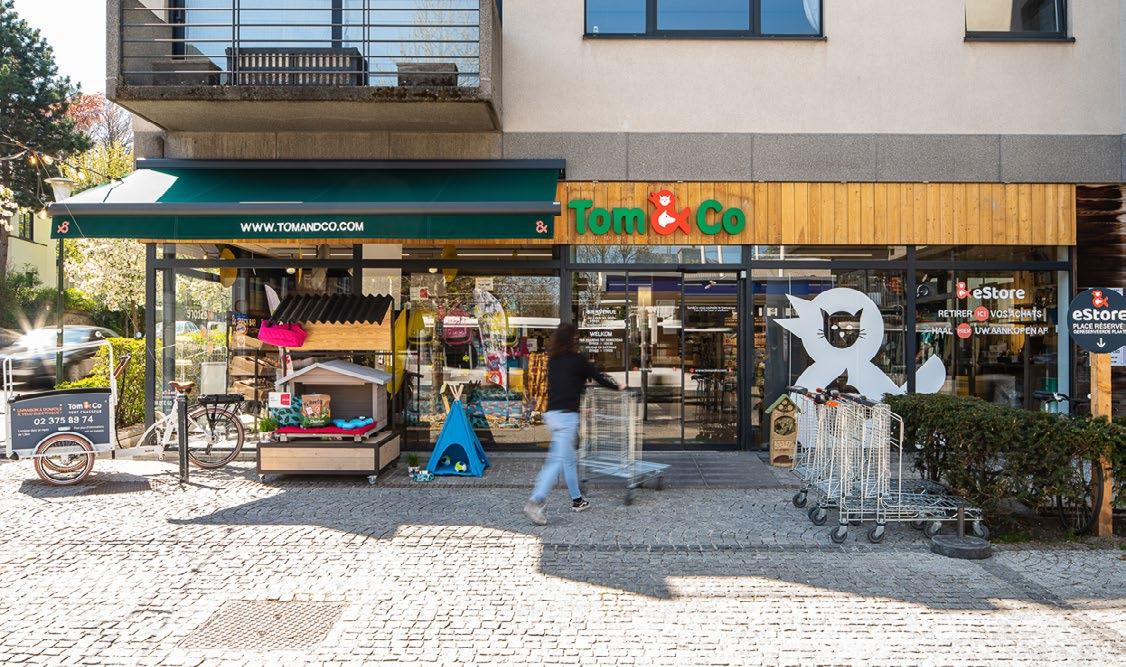

CEO MESSAGE
I am proud to present our first CSRD sustainability report—an important milestone in Tom&Co’s journey. More than just a collection of data, this document reflects our determination to become a more responsible, and environmentally conscious company.
For over 30 years, Tom&Co has been driven by a shared passion: the well-being of animals and their human companions. Today, this passion inspires us to rethink our impact across every part of our operations—from sourcing and logistics to packaging, services, and governance.
This report marks the beginning of an ambitious yet honest path forward. In 2024, we conducted our first double materiality assessment, measured our carbon footprint, identified key risks and opportunities, and launched concrete actions—such as improving energy efficiency, enhancing animal welfare practices, and making packaging more sustainable.
We know we’re not there yet. But we choose transparency, learning, and continuous improvement. Every step we take helps build a more resilient company that serves its customers, its people, the planet, and of course, our little companions. I want to sincerely thank our teams, franchise partners, suppliers, and customers for sharing in this vision and helping bring it to life every day. Together, we can lead the way towards more thoughtful, respectful, and sustainable practices in our industry.
Jean Richard de Latour


GOVERNANCE
EXECUTIVE COMMITTEE
The Executive Committee is the operational assembly of the organization, responsible for day-to-day business decisions. Its members are the functional leaders of the Tom&Co group (which encompasses Pharmapets and Vetostore). The executive committee meets every month. The committee is chaired by Jean RICHARD DE LATOUR.

JEAN RICHARD de LATOUR Chief Executive Officer (CEO)
More than 10 years of experience in retail, former CEO Carrefour Romania.
More than 10 years of CFO. He was CFO at Pharmapets before joining Tom&Co.
DE MOOR Chief Financial Officer (CFO)

More than 10 years of experience in retail, focused on category management.
LEFEVERE Chief Commercial Officer


HILDE DECADT Chief Operating Officer (COO) –Belgium
More than 20 years of experience in retail, focused on operations.
More than 15 years of experience in retail, namely leading a selection of french retail chains.
SAMUEL JODEAU Chief Operating Officer (COO) –France


SVEN DE WAELE Chief E-Commerce & Digital Officer
Founder of Pharmapets, more than 10 years experience in digital commerce.
More than 15 years of experience as a lawyer & legal officer.
DELAHAIJE Group Legal Counsel

PHILIPPE
WOUTER
HERBERT
BOARD OF DIRECTORS
The Board of Directors (Petserco Holding SRL) is an assembly responsible for decisions on strategic and high importance topics as well as all “board-reserved” matters such as budget approvals and investment decisions. The board meets every two to three months.

JESPER HOJER
Chairman of the
Board
RELEVANT EXPERIENCE
Former global CEO at Lidl, with experience in dealing with private equity owned companies.
EXTERNAL MANDATES
Chairman at MatsmartMotatos
Chairman at Oda
Chairman at Aera Payment & Identification
Board Member at Ontex
Senior Advisor at McKinsey & Company
Senior Advisor for other private equity companies
ROBERTO ITALIA
Board member

RELEVANT EXPERIENCE
CEO at Verlinvest SA, through Red Black Capital SA.
EXTERNAL MANDATES
Board Director at Red Black Capital S.A.
Board Director at Billy’s Sp.K. Zoo
Chairman of the board and Member of sustainability Committee at Avio SpA Italy
Board Director at Avio USA Inc.
Board Director at Space Holding SRL
Managing Director as permanent representative of Red Black Capital S.A. at Verlinvest SA
Board Director at Verlinvest India Investment Advisor Priv. Ltd.
Managing Director as permanent representative of Red Black Capital S.A. at Verlinvest Beverages SA
Managing Director as permanent representative of Red Black Capital S.A. at V Cube Ventures SA

Board member
RELEVANT EXPERIENCE
More than 20 years of experience in retail, former CEO at Tom&Co, Walmart Japan and The Very Group (UK).
EXTERNAL MANDATES
Board member, strategy committee & audit committee at Bpost group
GILLES
VANHOUWE
Board member

RELEVANT EXPERIENCE
More than 15 years of experience in private equity/ strategy consulting.
EXTERNAL MANDATES
Co-founder Thelakung, advisor to Verlinvest
Board member at Nesto (Rigel NV), through Thelakung BV
Co-founder at Wings Equity
Advisory board member at Mercatus BV
LIONEL DESCLEE
BOARD OF DIRECTORS

RELEVANT EXPERIENCE
More than 15 years of experience in investment banking, former CFO & CEO of Tom&Co.
EXTERNAL MANDATES
Senior Advisor at Vendis
Capital
Chairman at Fondation Reine Paola
Board Member at Finasucre
Board Member at D’leteren Group
le GRELLE
Board member

Board member
RELEVANT EXPERIENCE
More than 20 years of experience in retail, former CEO Carrefour France & Spain and co-founder of TechForRetail fair.
EXTERNAL MANDATES
Administrator at Groupe Casino
Advisory board member at Ida
Administrator at Uvesco
Senior Advisor at Kearney
Senior Advisor at Five Seasons Ventures
Board member at La Fourche
PHILIPPE DECHAMPS
Board member

RELEVANT EXPERIENCE
More than 20 years of experience in retail, pharma and biotech, former chief legal officer at Delhaize Group.
EXTERNAL MANDATES
Social project manager at Fondation Reine Paola
DELAHAIJE
Secretary of the Board

RELEVANT EXPERIENCE
More than 15 years of experience as a lawyer & legal officer.
PASCAL CLOUZARD
HERBERT
THIERRY
SHAREHOLDER INFORMATIONS
The Shareholders Assembly (Petserco Holding SRL) brings together all of the group’s shareholders and is responsible for approving any capital-related matters. The shareholders only meet on an ad hoc basis, when necessary.

Shareholder
RELEVANT EXPERIENCE
More than 15 years of experience in investment banking, former CFO & CEO of Tom&Co.
EXTERNAL MANDATES
Senior Advisor at Vendis Capital
Chairman at Fondation Reine Paola
Board Member at Finasucre
Board Member at D’leteren Group
RELEVANT EXPERIENCE
Founder of PharmaPets, more than 15 years as Veterinarian.

RELEVANT EXPERIENCE
Founder of Pharmapets, more than 10 years experience in digital commerce.

RELEVANT EXPERIENCE
More than 20 years of experience in retail, former CEO at Tom&Co, Walmart Japan and The Very Group (UK).
EXTERNAL MANDATES
Board member, strategy committee & audit committee at Bpost group.
RELEVANT EXPERIENCE
More than 20 years of experience in retail, pharma and biotech, former chief legal officer at Delhaize Group.
EXTERNAL MANDATES
Social project manager at Fondation Reine Paola


RELEVANT EXPERIENCE
Members from Tom&Co top management and middlemanagers.
Investment Holding Company.
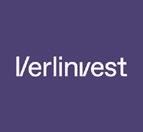
LIONEL DESCLEE
AUDIT COMMITTEE
The Audit Committee shall supervise and make recommendations to the Board regarding the financial reporting process of the Group and the integrity of the financial information, the effectiveness of the internal control and risk management systems of the Group, the internal audit, the statutory control of the annual and consolidated accounts and the Auditor’s independence. The Audit Committee meets twice a year.

RELEVANT EXPERIENCE
More than 20 years of experience in retail, former CEO at Tom&Co, Walmart Japan and The Very Group (UK).
EXTERNAL MANDATES
Board member, strategy committee & audit committee at Bpost group.
GILLES
VANHOUWE

RELEVANT EXPERIENCE
More than 15 years of experience in private equity/ strategy consulting.
EXTERNAL MANDATES
Co-founder Thelakung, advisor to Verlinvest
Board member at Nesto (Rigel NV), through Thelakung BV
Co-founder at Wings Equity
Advisory board member at Mercatus BV

le GRELLE
Chairman of the Audit Committee
RELEVANT EXPERIENCE
More than 15 years of experience in investment banking, former CFO & CEO of Tom&Co.
EXTERNAL MANDATES
Senior Advisor at Vendis Capital
Chairman at Fondation Reine Paola
Board Member at Finasucre
Board Member at D’leteren Group
LIONEL DESCLEE
THIERRY
NOMINATION AND REMUNERATION COMMITTEE
The Nomination and Remuneration Committee will make proposals to the Board regarding the renumeration policy and the individual remuneration of the CEO and the Executive Management and prepare and explains the remuneration report at the shareholders meeting of the company. The Nomination and Remuneration Committee meets twice a year.

RELEVANT EXPERIENCE
More than 20 years of experience in retail, pharma and biotech, former chief legal officer at Delhaize Group.
EXTERNAL MANDATES
Social project manager at Fondation Reine Paola
PASCAL CLOUZARD

RELEVANT EXPERIENCE
More than 20 years of experience in retail, former CEO Carrefour France & Spain and co-founder of TechForRetail fair.
EXTERNAL MANDATES
Administrator at Groupe Casino
Advisory board member at Ida
Administrator at Uvesco
Senior Advisor at Kearney
Senior Advisor at Five Seasons Ventures
Board member at La Fourche

RELEVANT EXPERIENCE
Former global CEO at Lidl, with experience in dealing with private equity owned companies.
EXTERNAL MANDATES
Chairman at MatsmartMotatos
Chairman at Oda
Chairman at Aera Payment & Identification
Board Member at Ontex
Senior Advisor at McKinsey & Company
Senior Advisor for other private equity companies
Chairman of the Nomination and Remuneration Committee
PHILIPPE DECHAMPS
JESPER HOJER
ESG STRATEGY
BASIS FOR PREPARATION
This document outlines Tom&Co’s commitment to sustainability, aligned with the European Corporate Sustainability Reporting Directive (CSRD) and its associated standards (ESRS). It also includes information on Tom&Co’s progress regarding the United Nations’ 17 Sustainable Development Goals (SDGs), with a particular focus on five priority SDGs.

This is Tom&Co’s first report according to the CSRD and ESRS standards. To comply with these standards, Tom&Co relied on the official guidelines provided by the European Financial Reporting Advisory Group (EFRAG), particularly Implementation Guidance 3 (IG-3). Only data points identified as essential through a double materiality assessment and deemed mandatory are included. Optional data is not featured in the report.
In the future, Tom&Co will continue to enhance and enrich its disclosures to meet ESRS requirements.
REPORTING SCOPE
The scope of Tom&Co’s sustainability statement includes all operations of Tom&Co Belgium, Tom&Co France and its e-commerce activities. As the Barq entity (including the online platforms Pharmapets & Vetostore) was acquired in 2024, it was excluded from the scope of the double materiality assessment and, consequently, from the report. Given that franchised stores represent a significant part of Tom&Co’s operations — accounting for over 50% of the brand’s total network — a distinction was made, where relevant, between initiatives implemented in company-owned stores and those in franchised stores. Key performance indicators (KPIs) related to various sustainability issues were also differentiated accordingly, when appropriate, to ensure a more accurate representation.
The reporting period covers January 1, 2024, to December 31, 2024. Additionally, the sustainability statement covers both the upstream value chain and downstream business relationships associated with the direct use of its products. For further details, refer to the sections: «Strategy, Business Model, Values and Value Chain.»
DISCLOSURES
RELATED TO SPECIFIC CIRCUMSTANCES
TIME HORIZONS
The time horizons follow the definitions provided by the CSRD standard. The short term corresponds to one year. Medium-term covers two to five years. Long-term exceeds five years.
VALUE CHAIN ESTIMATIONS
Certain data points are based on estimates, as they depend on information provided by partners. When information is unavailable for a specific scope or for quantitative metrics related to its value chain, Tom&Co may rely on estimates or relevant proxies. Such instances are clearly indicated in the metrics section.
SOURCES OF ESTIMATIONS AND OUTCOME UNCERTAINTY
When information is unavailable for a specific scope or for quantitative metrics related to its value chain, Tom&Co may rely on estimates or relevant proxies. Such instances are clearly indicated in the metrics section.
CHANGES OR ERRORS IN PREVIOUS REPORTS
This is Tom&Co’s first sustainability report prepared in accordance with the CSRD requirements. No changes or errors have been identified to date.
INCORPORATION BY REFERENCE
ESRS Disclosure requirements Supporting sections
ESRS2 SBM-2 - 45aEngagement with stakeholders
ESRS2 IRO-1 – 53b iii - Double materiality analysis
ESRS2 BP 1 – 5 - Basis for preparation ESRS 2 SMB2 - Business Model, Value Chain and Strategy
ESRS 2 IRO 1 – Double materiality analysis ESRS 2 SMB2 - Business Model, Value Chain and Strategy
ESRS E4 MDR - Biodiversity ESRS G1 MDR - Partnerships
ESRS S4 MDR - Accessibility of products and services ESRS E2 MDR - Transport & Logistics
GOVERNANCE OF ESG STRATEGY
To ensure effective oversight, sustainability and ESG matters are addressed at the executive committee level. The executive committee was itself advised by an external firm specialized in ESG reporting. Once the topics have been identified, responsibilities are divided as follows: for each material sustainability issue, Tom&Co has appointed a «topic owner.» This person is responsible for gathering data related to the specific issue. The «topic owner» may be a member of the executive committee or an employee with the necessary expertise. In addition to the «topic owner», Tom&Co has also designated a responsible person from the executive committee for each key sustainability issue. This person is responsible for ensuring that data collection is followed up. Each issue is reviewed and updated at least once a year.
Juliette Hamer, CSRD project coordinator, ensures report compliance. She manages the materiality analysis, carbon assessment and audit, and approves the final report.
In 2024, sustainability issues were not reviewed by an audit committee. The decision to audit sustainability issues is pending finalization by the Audit and Remuneration Committees.
There is currently no procedure involving the Board of Directors or shareholders in the definition of sustainability issues. Only members of the Executive Committee have been involved in identifying sustainability issues. The members of the Executive Committee feel that they have sufficient knowledge on sustainable development issues.
INCENTIVE SYSTEM
In 2024, no remuneration system linked to achieving sustainability objectives was in place for any governance body. There are currently no plans to establish such a system in the medium term. The company prefers to focus first on monitoring and improving its sustainability impacts, risks, and opportunities.
Climate action
Energy management
Transport & Logistics
Water management
Impact on nature and biodiversity
Product lifecycle management
Waste management
Sustainable packaging
Safety, health, and well-being
Accessibility of products and services
Animal Welfare
Ethics and Governance
Partnerships
Responsible marketing
Wouter Lefevere
Michael Verstappen
Marvin Vanparys
Wouter Lefevere
Wouter Lefevere
Wouter Lefevere
Michael Verstappen/ Wouter Lefevere
Elodie Bodin
Sandrine de Borchgrave
Hilde Decadt
Emilie Willemarck
Sandrine de Borchgrave
Hilde Decadt
Peter Coppens
Wouter Lefevere
Hilde Decadt
Wouter Lefevere
Wouter Lefevere
Wouter Lefevere
Wouter Lefevere
Wouter Lefevere/ Hilde Decadt/ Samuel Jodeau
Wouter Lefevere
Sandrine de Borchgrave
Hilde Decadt
Hilde Decadt
Sandrine de Borchgrave /Hilde Decadt
Hilde Decadt
Herbert Delahaije
BUSINESS MODEL, VALUE CHAIN AND STRATEGY
BUSINESS MODEL
Tom&Co is a Belgian pet specialty retailer founded in 1991 by a food distribution group. Over the past 30 years, Tom&Co has continuously evolved and specialized, expanding its product range, developing own brands with in-house recipes, offering an increasing number of services, and building strong partnerships with associations and experts. Their significant product groups include pet (fish, rabbit, birds, rodents), pet food, accessories, and supplies. Additionally, Tom&Co offers professional advice to pet owners through their specialist staff, with animal welfare at the core of its business.
Today, Tom&Co is reinforcing the store concept as a meeting and sharing space, bringing together a community of passionate pet owners. In 2024, the company operated 43 integrated stores and 159 franchised stores, located in France, Belgium and Luxemburg. Tom&Co’s headquarters are based in Belgium, and the retail network is served via a logistics hub in Willebroek. As of December 31, 2024, the company reported an annual revenue of 3289 million and employed 302 people.
In May 2022, Verlinvest acquired a majority stake in Tom&Co, a move that underscores its growth and prominence in the pet retail industry.
Tom&Co’s commitment to quality and customer satisfaction has solidified its position as a trusted provider in the pet care market. With a focus on expanding their product offerings and services, the company continues to cater to the evolving needs of pet owners in its key markets.
VALUE CHAIN
Tom&Co operates within a value chain, covering various stages from sourcing to retail sales.
The company’s primary product offerings are divided into two main categories: food and non-food products. Some of these products are from Tom&Co’s own-brand range, while others come from national brands. Food products originate mainly from agricultural sources, including meat, cereals, vegetables, and other raw ingredients essential for animal nutrition. These products are carefully sourced to ensure quality, nutrition, and safety standards for pets. Non-food products, such as accessories, bedding, toys, and hygiene products, are predominantly manufactured using diverse raw materials, including plastics, textiles, metals, and wood.
Customers of Tom&Co have the option to purchase a wide range of items, including pets, pet food, and accessories. Purchases can be made through two primary channels: in-store at physical retail locations and online via e-commerce platforms. Tom&Co’s brick-and-mortar stores offer customers direct interaction with products and animals, as well as personalized advice from trained staff. The company’s e-commerce presence allows customers convenience through home delivery and click & collect services.
Logistics between stores/ customers and warehouses rely predominantly on road transportation, with trucks regularly moving products between distribution centers and retail locations.
Regarding sustainability, several critical challenges arise within Tom&Co’s value chain. Agricultural sourcing poses significant environmental impacts, such as biodiversity loss, water consumption, and greenhouse gas emissions. Raw material extraction for non-food products also contributes
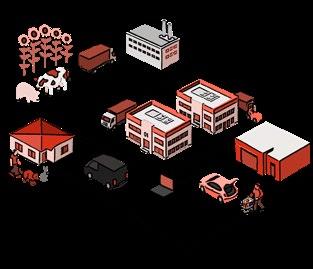
to environmental strain, particularly concerning resource depletion and pollution. Transportation between warehouses and stores/customers generates emissions contributing to air pollution and climate change. Lastly, the packaging used for products presents sustainability concerns related to waste generation, recyclability, and resource use. For own brand products, Tom&Co has control over specifications and sourcing and can directly apply sustainability initiatives. For the other products, Tom&Co leads a permanent dialogue with national brands around sustainability issues, inviting them to adopt best market practices and enhance their sustainability standards.
THREE
STRATEGIC SUSTAINABILITY THEMES TO FOSTER FUTURE BUSINESS RESILIENCE:
PEOPLE, PETS & OUR SHARED PLANET


PEOPLE

Employees well-being is fundamental to Tom&Co’s success, as competent and motivated employees directly improve customer experience and loyalty. Therefore, Tom&Co invests in regular training programs, promotes fair employment practices and guarantees safe working conditions. These initiatives are in line with SDG 8 (decent work and economic growth) and SDG 3 (good health and well-being).

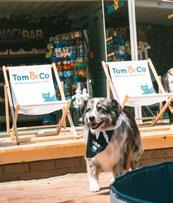
PETS
Animal welfare is one of Tom&Co’s main areas of work. Tom&Co has been proactive in this field for over 30 years. The company follows animal welfare standards. It trains its staff in animal care. It ensures that its animal suppliers adopt ethical practices. This commitment is in line with SDG 15 (Life on Earth) and is essential to maintaining customer trust, ensuring the health and safety of animals and reinforcing the integrity of the Tom&Co brand.



OUR SHARED PLANET
Tom&Co recognizes that its activities, notably procurement and transport, have an impact on the environment, particularly in terms of greenhouse gas emissions. The company is pursuing strategies to reduce this impact namely by challenging suppliers, optimizing logistics and improving the energy efficiency of its buildings. These initiatives are in line with ODD 13 (Climate Action). In addition, given the wide range of pet products, from food to accessories, Tom&Co is working on limiting the amount and the environmental impact of the packaging used, namely driving higher recyclability of the packaging used for its own brands. This approach is in line with SDG 12 (Responsible Consumption and Production) and helps to alleviate problems such as resource depletion, pollution and waste.
These strategic priorities demonstrate Tom&Co’s longstanding commitment to responsible business practices and sustainability, aligning closely with evolving market expectations and consumer values.

ENGAGEMENT WITH STAKEHOLDERS
At Tom&Co, listening to and collaborating with stakeholders is essential. Their feedback helps the company move forward towards common goals.
The executive committee identified all of Tom&Co’s stakeholders. Key stakeholder groups include employees (franchises and integrated stores), shareholders and boards, customers, suppliers (own brand and national brand), live animal suppliers, producers, NGOs, banks and insurance entities, professional authorities, logistics providers, media.
Seven different types of questionnaires were distributed. These were tailored according to the audience and language.
ŀ Employee (French and Dutch)
ŀ Board and shareholders (English)
ŀ Franchises (French and Dutch)
ŀ Suppliers and partners (English)
ŀ People invited to round table (English)
In total, 100 responses were collected, and 183 comments were obtained (see more details in Appendix B).
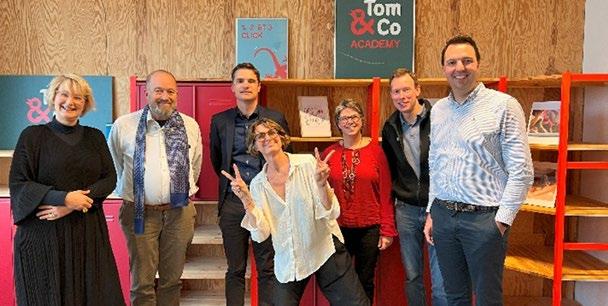
In addition to sending out questionnaires, Tom&Co also organized a roundtable discussion with selected stakeholders. Here is the list of participants.
ŀ Kristel Peeters – Nestlé – CSR Manager
ŀ Greer Wild – Edgar &Cooper (on Teams)- Sustainability
ŀ Kathy Heugens – Mars et Bepefa - Sustainability
ŀ Thomas Winter – Versele Laga (producteur- Mkg & Sust)
ŀ Philippe Salaert – Distrilog - CEO
ŀ Leender Post – Van de Poel - Sustainability
ŀ Baudoin Oldenhove – Natagora – Sales
Following the sending of the questionnaires and the round table, here are the main areas of work identified. All the results were presented to the executive committee. The table below represents results.
Animal welfare Recommendation to address pet care services, such as improving dog wash systems and create partnerships with other organisations.
Sustainable packaging Need for better recycling practices and reducing packaging waste highlighted. Encouragement of bulk sales or eliminating unnecessary plastic use in the supply chain.
Energy management Focus on renewable energy usage and improving energy efficiency in buildings and stores. Suggestion to install photovoltaic panels at franchised locations.
Employee health and wellbeing Communication between staff, stores and head office highlighted as key improvement area. A healthy working environment is needed to retain and develop all staff.
Governance Communication improvement with both employees and customers about sustainability initiatives. Key to avoid "greenwashing" and focus on honest and transparent reporting.
Working conditions for franchises Inclusion of franchised stores in sustainability and employee policies. Suggestion to provide tools and guidance to franchisees for better alignment with ESG goals.
Responsible marketing Recommendation to promote local sourcing and collaboration with sustainability-focused brands. Use of visuals and simple language for customer communication about ESG efforts.
Stakeholder consultation has allowed for prioritization of certain sustainability issues over others. This prioritization is visually represented in the dual materiality matrix by bubbles of varying sizes. For more details, see the sections “Double Materiality Analysis”.
MATERIAL IMPACTS, RISKS AND OPPORTUNITIES
DOUBLE MATERIALITY ANALYSIS
In 2024, Tom&Co conducted its first double materiality assessment. This framework is used by companies subject to the CSRD to identify so-called «material» issues—those which must be disclosed.
Double materiality assessment considers two perspectives: financial materiality and impact materiality. Financial materiality reflects how ESG issues affect the company’s financial performance, while impact materiality assesses how the company’s activities influence ESG topics.
Phase I : Understanding the business model and value chain
The first step to identifying and assessing significant impacts, risks, and opportunities for Tom&Co involves mapping and understanding its business model and value chain. Key resources and stakeholders were thus mapped. This exercise helps define the scope for the double materiality assessment. For more details, see the section «Strategy, Business Model, and Value Chain.
Phase II : Identification of impacts, risks and opportunities
This phase was conducted in two parts: the identification of ESG impacts (impact materiality) and the identification of financial risks and opportunities (financial materiality). An impact is defined as an actual or potential consequence of an organization’s actions on people and/or the environment, which can be either positive or negative. A risk represents a potential threat to financial performance, while an opportunity means a potential benefit for financial performance.
IMPACT MATERIALITY
Tom&Co’s impacts were identified during a half-day workshop held at the organization’s headquarters, attended by a part of the working group (see Annexes A). Participants asked to evaluate environmental, social, and governance impacts.
The external organization supporting the process guided the executive committee in identifying both positive and negative impacts in line with the CSRD and the ESRS thematic standards. Each impact identified was reviewed and discussed by the groups using the question, «Is this a consequence of our activities?» If an impact was deemed relevant to Tom&Co’s activities, the group specified:
ŀ Whether it concerned the organization’s own operations or its value chain,
ŀ Whether it was an actual or potential impact,
ŀ A brief description of the impact.
As each impact relates to a sustainability topic, the identified impacts served as a foundation to define Tom&Co’s sustainability issues. A plenary discussion then validated the impacts, the associated issues, and their aggregation or disaggregation.
FINANCIAL MATERIALITY
Tom&Co’s financial risks and opportunities were identified during another half-day workshop at the organization’s headquarters, conducted on the same day as the impact workshop and involving the executive committee.
The objective of this workshop was to identify the financial risks and opportunities linked to each impact or, more broadly, each sustainability issue.
Finally, a plenary discussion was held to validate the identified risks and opportunities.
Phase III : Identification of material issues through scoring impacts, risks and opportunities (IROs)
From the list of identified issues, the next step is to determine which ones are material.
To achieve this, we applied the ESRS 1 criteria in our analysis. These criteria include, for impacts: scope, scale, remediability, and likelihood, as well as the probability and magnitude of financial effects for risks and opportunities. The table below explains how each impact, risk and opportunity is scored.
The CSRD does not specify the scale to be used for these evaluations. Therefore, Tom&Co chose internationally recognized standards from the United Nations Guiding Principles (UNGPs).
All impact assessments on environmental and human aspects were carried out by Vanessa Nicolai, former coordinator of the ESG strategy. The identification and evaluation of risks and opportunities were conducted by the Chief Financial Officer.
After all impacts, risks, and opportunities were scored, the materiality matrix was presented and discussed collectively. It was decided that Tom&Co’s material issues would be those scoring above 2.5 for financial materiality, impact materiality, or both.
Results of double materiality analysis
Here are the results of double materiality analysis.
The red bubbles represent social issues, the light green bubbles represent environmental issues, and the dark green bubbles represent governance issues. Based on the results of the double materiality analysis, the material issues are those located within the colored quadrants. The size of each bubble reflects the level of importance stakeholders place on these issues.
The 14 sustainability issues identified by Tom&Co following the three workshops are as follows:
ESG Topics Description
Animal Welfare
Ethics and Governance
Partnerships
Responsible marketing
Climate action
Energy management
Water management
Impact on nature and biodiversity
Product lifecycle management
Waste management
Sustainable packaging
Transport & Logistics
Safety, health, and well-being
Accessibility of products and services
As a pet specialty retailer, Tom&Co has a duty to promote and improve practices relating to the welfare and respect of animals, both in its own activities and upstream, in its supply chain, and downstream, among pet parents. The benefits of companion animals for mental, social and physical health, as well as emotional and psychological development, have been proven. In response, Tom&Co wants to contribute to a better understanding of animal welfare and to promote better practices in society. The fight against the abandonment of pets is also a key issue for a pet specialty retailer. To this end, the company positions itself as a privileged partner of the authorities on issues of animal welfare and respect and works with associations.
Tom&Co wants to ensure transparent, fair and responsible governance. This means complying with the law, preventing and actively combating corruption and honouring commitments. Good governance also includes accountability, effective risk management and honest communication with employees, customers and partners. Tom&Co must also ensure that its suppliers and partners follow the same principles.
Tom&Co's ecosystem is made up of many partnerships, whether in terms of supply, logistics, distribution of products and services or its role in promoting animal welfare. Maintaining its current partnerships through transparency and enhanced dialogue, and forging new ones, means improving the company's resilience and ability to fully implement its strategy. These partnerships will facilitate industry-wide changes, driving the adoption of more sustainable practices.
The regulatory context is tending to demand ever higher levels of consumer information and respect for privacy. Tom&Co is part of this trend, whether in terms of data protection or avoiding greenwashing practices. Responsible marketing must also enable customers to choose the most sustainable products that are best suited to the well-being and health of their animals.
Tom&Co's activities generate greenhouse gases: during production, transport, sales in stores, etc. Climate risks also threaten the company's supply chain (e.g. shortages or price rises linked to agricultural losses) and store traffic (e.g. low customer numbers during periods of extreme heat). By investing in its climate strategy, Tom&Co should be able to play its part and strengthen its resilience.
The energy requirements associated with running shops are significant, especially when the buildings are not very efficient or when live animals are sold. Given that Tom&Co has more than 200 shops, reducing energy consumption is a strategic environmental objective. Furthermore, reducing energy costs has a direct impact on operating margins and therefore the financial health and investment capacity of shops.
The production of the raw materials used by Tom&Co (agricultural products, meat, cereals, textiles, etc.) represents a significant consumer of fresh water and a source of water pollution. The shops in the distribution chain require significant quantities of water, for example for the care of aquatic animals or for the dog wash. The products and services sold by Tom&Co have the potential to contribute to water pollution (shampoos, anti-parasites, textile care, etc.).
In the context of an unsustainable supply chain, the majority of raw materials (agricultural products, meat, cereals, textiles, etc.) used to manufacture Tom&Co products have an adverse impact on the environment, contributing additionally to biodiversity loss. At the operational level, Tom&Co's business model is based on a large logistics network and a significant number of points of sale, which has resulted in the artificialisation of land and thus on biodiversity loss.
In Belgium, 60% of households welcome a pet. The environmental impact of pet parenting is significant and cannot be overlooked. Tom&Co has a responsibility to play its part in making pet parenting sustainable through its range of products and services. This entails controlling and reducing the environmental impact of products at every stage of their life cycle, from design to end-of-life, while integrating the principles of the circular economy into the core of our offering.
Tom&Co's operations result in waste, primarily associated with logistics and in-store sales. It is essential that the company takes action to reduce waste at the source, as well as to sort it as selectively as possible. The reduction of waste, particularly residual waste, will also result in a reduction of associated costs.
The retail sector is a significant consumer of materials, particularly plastics, for packaging purposes. Tom&Co can contribute to decreasing this impact by identifying and eliminating any over-packaging practices that may contribute to environmental impact, as well as developing packaging solutions with a reduced environmental footprint.
Downstream Tom&Co supplies more than 200 shops in the Benelux and France every week. A large quantity of parcels is sent to e-commerce customers every year and this number keeps on growing. Upstream, the company procures its supplies in Europe and globally. Supply chain management is one of its core businesses, and making transport more sustainable is an important way of reducing its environmental footprint.
Staff are exposed to health risks (ergonomics, handling of heavy loads, etc.). Working conditions can be difficult due to staff shortages, customer attitudes and the challenge of balancing work and personal life in the retail sector. Tom&Co is committed to ensuring the safety and well-being of all its employees. A motivated and healthy workforce is also a competitive advantage for the company. Integrated stores must also apply high working conditions standards and ensure legal compliance. In fact, as they represent the brand, any scandal or legal action in this area would have a negative impact on the brand's image.
Tom&Co wants to guarantee geographical accessibility, which means having outlets that are well located and, where possible, accessible by low-carbon transport. The shops and website should also be accessible to people with handicap. Finally, improving the affordability of products and services will enable more vulnerable pet owners to benefit from quality products and provide adequate care for their pets.
ENVIRONMENT
ESRS E1 CLIMATE ACTION
Tom&Co’s activities generate greenhouse gases: during production, transport, sales in stores, etc. Climate risks also threaten the company’s supply chain (e.g. shortages or price rises linked to agricultural losses) and store traffic (e.g. low customer numbers during periods of extreme heat). By investing in its climate strategy, Tom&Co should be able to play its part and strengthen its resilience.
KEY FIGURES AND ENGAGEMENT
ŀ 111 553,9 t CO2 emitted in 2023
ŀ 369,4 tCO2e/FTE Carbon Intensity per FTE
ŀ Objective of electrifying the vehicle fleet 100% by 2029
CLIMATE ACTION IROS
ESRS Sub- topic Location Impact, Risk or Opportunity Description
ESRS E1 – Climate Change / Own operations Real negative impact
Value Chain Real negative impact
Value Chain Real negative impact
Product distribution involves significant energy consumption in stores, exacerbated by the poor performance of some buildings and the sale of live animals (aquarium feed, especially for tropical fish, vivariums, air-conditioning requirements, etc.), the digital footprint (notably e-commerce), logistics to supply stores and deliver e-commerce customers, and staff and customer mobility. Air-conditioning systems contain powerful GHGs.
Intensive agriculture, forestry and fishing are responsible for significant GHG emissions, as is the extraction of raw materials for the manufacture of non-food products. Global sourcing, involving long-distance transport, also generates significant GHG emissions.
Surface ozone (O3) is a secondary pollutant produced in the atmosphere in the presence of sunlight and chemical precursors, the main ones being nitrogen oxides (NOx) and volatile organic compounds (VOCs), mainly from transport and industrial activities. It is harmful to both the environment and human health. Tropospheric ozone is formed, among other things, by pollutant emissions linked to road freight (fossil fuels). It is a GHG whose impact on the climate is more localized, due to its short atmospheric lifetime, but powerful.
Value Chain Potential positive impact The production of cereals for animal feed requires intensive farming practices. Adopting more sustainable practices will enable the entire value chain to reduce its impact on biodiversity and climate change.
Opportunity
Working on climate change mitigation could lead to cost reductions. These include energy, relocation of logistics costs, the end of live pets in a selection of stores , cheaper click & collect, and cross-selling with e-Commerce platforms.
Risk Introduction of a carbon tax leading to reduced profit margins
Risk Financial risks arising from storms and floods causing damage to stores.
Risk Loss of sales because customers don't come to the store during heatwaves.
STRATEGY OF RISK MITIGATION
Given their potential impact, the three climate change risks identified merit particular attention. For each identified risk, mitigation measures have been considered to limit exposure or reduce consequences.
ESG Topic Risk description
Mitigation strategy
Climate action Introduction of a carbon tax leading to reduced profit margins. Along with this first CSRD report, Tom&Co has measured its carbon footprint and started building scenarios for carbon emissions decrease in 2025.
Financial risks arising from storms and floods causing damage to stores.
Loss of sales because customers don't come to the store during heatwaves.
GOVERNANCE
As mentioned in the incentive system section, in 2024, no remuneration system linked to achieving sustainability objectives was in place for any governance body. Thus, climate-related considerations are not taken into account in the remuneration of governance bodies.
STRATEGY
Ongoing programme of store renovation across all geographies
Opportunity for Tom&Co's customers to purchase their products online and have them delivered. Ongoing project to develop e-commerce.
Here are the three climate risks identified by Tom&Co. Two are physical risks and one is transitional risk.
Transitional risk
ŀ The introduction of carbon tax reduces margins –medium term
Physical risks
ŀ Financial risks arising from storms and floods causing damage to stores - long term
ŀ Loss of sales because customers don’t come to the store during heatwaves – long term
In 2024, no resilience analysis of Tom&Co’s activities and no scenario analysis have been carried out. However, the identification of various impacts, risks and opportunities related to climate change has reinforced Tom&Co’s conviction that it is essential to take proactive measures to adopt a more sustainable business model. The company is therefore optimising logistics and reducing transport-related emissions.
TRANSITION PLAN AND CARBON FOOTPRINT RESULTS
Tom&Co is committed to playing its part in contributing to a low-carbon economy. Finalized in 2025, Tom&Co conducted a carbon footprint assessment for the year 2023, resulting in total emissions of 111 554 tCO2e (tons of carbon dioxide equivalent), based on the Méthode Bilan Carbone®. The assessment also complies with the Greenhouse Gas Protocol and covers the entire company, including both integrated stores and franchises.
In line with its business model, the main source of emissions is the purchase of goods and services, accounting for over 64% of the company’s global footprint. This includes products for sale, as well as goods and services supporting internal operations.
The second-largest source of emissions is travel, comprising employee commuting, business travel, and travel by visitors and customers, namely given the high number of clients visiting Tom&Co’s physical stores.
Freight ranks third, contributing to approximately 4% of global emissions. These emissions primarily result from the transportation of goods from suppliers to logistics hubs and stores.
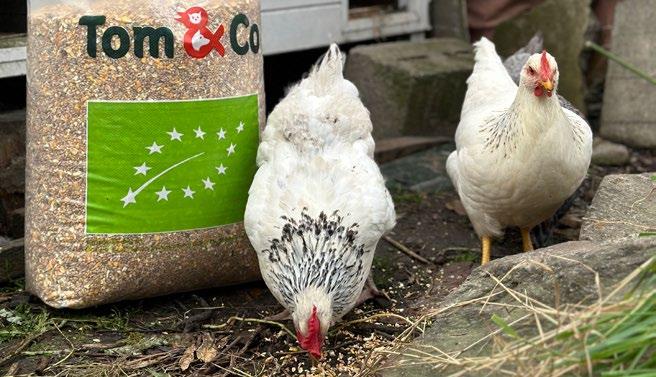
POLICIES
Tom&Co has conducted its first carbon footprint assessment, marking an important step in understanding and addressing its environmental impact. By integrating sustainability into its operations, the company aims to not only contribute to global climate action but also enhance its resilience.
ACTIONS AND TARGETS
In 2024, Tom&Co calculated its first carbon footprint based on 2023 data. A review was also initiated on optimizing logistics and reducing kilometers traveled, by interviewing and discussing with its logistics suppliers. At the same time, Tom&Co has also launched the process of transitioning to electric vehicles for its employees, recognizing the crucial role of decarbonizing the fleet in reducing emissions.
IN THE FUTURE
Regarding electrification, Tom&Co aims for 100% of its own fleet to be electric by 2029, and 80% by end of 2026.
To ensure continued progress, Tom&Co is committed to conducting an annual assessment of its carbon footprint. This ongoing assessment will enable the company to set increasingly ambitious emission reduction targets and refine its global climate strategy.
METRICS
The table below outlines the metrics that Tom&Co aims to track in the future regarding climate action issue.
ESRS E1 ENERGY MANAGEMENT
The energy requirements associated with running shops are significant, especially when the buildings are not very efficient or when live animals are sold. Given that Tom&Co has more than 200 shops, reducing energy consumption is a strategic environmental objective. Furthermore, reducing energy costs has a direct impact on operating margins and therefore the financial health and investment capacity of shops.
KEY FIGURES AND ENGAGEMENT
ŀ 256 MWh heating consumption in integrated stores
ŀ 2 112 MWh electricity consumption in integrated stores
ŀ By 2026, all integrated stores will be equipped with energy measurement systems
ŀ By 2025, all integrated stores will switch to LED
ŀ By 2026, all integrated stores’ heating will be managed centrally
ESRS Sub- topic Location Impact, Risk or Opportunity Description
ESRS E1 – Climate Change Energy management
Own operations Potential positive impact Few integrated stores are currently equipped with renewable electricity generation facilities. The installation of photovoltaic systems would contribute to production capacity in Belgium and France. In addition, Tom&Co plans to install electric terminals in its parking lots.
Opportunity Lower energy costs if Tom&Co is more autonomous and less dependent on the grid and price variations.
Opportunity Lower consumption of clean energy for self-generated energy (= via PV panels on stores). It reduces costs.
Risk
Risk of increased fuel prices for import transportation.
Risk Rising costs for the company in case of rising cost of energy.
STRATEGY OF RISK MITIGATION
Given their potential impact, the two energy management risks identified merit particular attention. For each identified risk, mitigation measures have been considered to limit exposure or reduce consequences.
ESG Topic Risk description Mitigation strategy
Energy management Risk of increased fuel prices for import transportation. Tom&Co aims to source its materials increasingly from the European Union, with large food product suppliers namely based in Belgium and the North of France.
Rising costs for the company in case of rising cost of energy Ongoing project to improve facility efficiency, implemented gradually rather than across all stores simultaneously.
POLICIES
The company is committed to managing energy responsibly across all its operations by reducing energy consumption, improving efficiency, and utilizing renewable energy sources where feasible. Through this commitment, Tom&Co aims to minimize its carbon footprint, contribute to global sustainability goals, and enhance operational performance. By optimizing energy use, the company not only reduces costs and environmental impact but also ensures long-term resilience in the face of evolving climate regulations and energy market fluctuations.
ACTIONS & TARGETS
In Belgium, all integrated stores use green electricity contracts with Engie, a requirement that also applies to new franchised stores, with existing franchisees encouraged to follow. One integrated store in Belgium and one in France are equipped with photovoltaic panels, and discussions with landlords have been started to install more in integrated stores in Belgium and France. However, many of the stores’ configuration will not allow for the placement of panels and different energy initiatives will have to be undertaken.
To reduce energy consumption, franchisees have been informed about energy-saving solutions, including their implementation and cost benefits.
Tom&Co has also reduced the number of live animal installations in new store openings. The number of installations per store has been reduced to two, compared to three to five in the past. In addition, the central plant islands have been replaced by more energy-efficient wall displays. This energy reduction strategy will be applied in the renovation of up to 60 stores in 2025 and 2026.
IN THE FUTURE
Tom&Co plans to go even further in reducing energy consumption. A pilot project will introduce an automation system in a store, with plans to expand the initiative if successful. By end of 2026, all integrated stores will be equipped with energy measurement systems, allowing for real-time monitoring and intervention.
The company is also studying remote-controlled heating systems for better temperature management, with tests starting in French integrated stores. By 2026, the heating of all integrated stores will be managed centrally from the head office, ensuring greater efficiency and lower energy consumption.
In terms of electricity, all Belgian integrated stores will switch to LED lighting by end of 2025, which requires a modification in 7 stores. Franchisees in Belgium will also benefit from attractive pricing options for LED installations. In Belgium, single-tariff meters will be replaced by digital meters, allowing automatic management of the dual tariff. At the same time, the last seven integrated stores in France still on the yellow tariff will switch to the blue tariff, a more economical electricity tariff.
In addition, a test is ongoing in an integrated store to install dynamic lighting systems, decreasing the intensity of lighting to 50% when nobody is in the area. Tom&Co has plans to expand the system if successful.
METRICS
The table below outlines the metrics that Tom&Co aims to track in the future regarding energy issue.
ESRS E2 TRANSPORT & LOGISTICS
Downstream Tom&Co supplies more than 200 shops in the Benelux and France every week. A large quantity of parcels is sent to e-commerce customers every year and this number keeps on growing. Upstream, the company procures its supplies in Europe and globally. Supply chain management is one of its core businesses, and making transport more sustainable is an important way of reducing its environmental footprint.
KEY FIGURES AND ENGAGEMENT
ŀ 113 fewer pallets being used in Belgium
ŀ Fill rate of 98% in France and 77% in Belgium
TRANSPORT AND LOGISTICS IROS
ESRS Sub- topic Location Impact, Risk or Opportunity Description
ESRS E2 – Pollution Transports & Logistics
Own operations Real negative impact Air pollution linked to road transport has significant impacts on human health, including respiratory and cardiovascular problems and increased risk of cancer.
Value Chain Real negative impact In Belgium and France, the breakdown of energy used in road transport is still largely dominated by fossil fuels (around 90% in France and a similar proportion in Belgium), and the same applies to Tom&Co's logistics (store supplies and e-commerce). Gasoline and diesel-powered vehicles are a major source of air pollution.
Risk
STRATEGY OF RISK MITIGATION
Three types of transportation must be distinguished: import transportation, transportation between stores, and e-commerce transportation. In the event of significant air and water pollution, the company may face legal restrictions or be required to pay fines.
Given its potential impact, the transport & logistics risk identified merit particular attention. For each identified risk, mitigation measures have been considered to limit exposure or reduce consequences.
ESG Topic Risk description Mitigation strategy
Transport & Logistics Three types of transportation must be distinguished: import transportation, transportation between stores, and e-commerce transportation. In the event of significant air and water pollution, the company may face legal restrictions or be required to pay fines.
The company is currently in the process of optimizing its supply chain with a focus on warehouse to store (where it has highest level of control), which will limit kilometers traveled and limit impact of such restrictions. Potential partners are required to submit their sustainability programme during the process.

POLICIES
Tom&Co is dedicated to minimizing the environmental impact of its transport and logistics operations while remaining efficient. Efficient transportation is crucial for Tom&Co, as it ensures timely store deliveries and product availability.
To achieve this, Tom&Co aims to optimize delivery routes, reduce fuel consumption, and prioritize low-emissions transportation methods.
ACTIONS & TARGETS
One of the main improvements was the switch from wooden to plastic pallets in Belgium, which reduced the weight of pallets by approximately 10 kg. This change resulted in 113 578 fewer pallets being used during the year, optimising space and reducing material waste.
Tom&Co is also actively working to reduce unnecessary journeys in order to improve efficiency and reduce emissions.
On the transporter side, Distrilog is working on the use of biodiesel (HVO), although this initiative is not exclusive to customer Tom&Co. Vandepoel also monitors its fine particle emissions. Vandepoel achieved a 98% fill rate, exceeding its target of 95%, while Distrilog operated at a 77% fill
rate, impacted by the fact that Tom&Co asked it to set fixed delivery times in store. The annual distances covered are 2 309 885 (including 45 942 exclusively for Tom&Co) for Vandepoel and 900 000 km for Distrilog in Belgium, with approximately 300 deliveries per week, for a total of approximately 15 000 per year.
IN THE FUTURE
Tom&Co is working on several initiatives to further reduce its emissions and improve efficiency. The company is evaluating energy-efficient warehouse options, including BREEAM and EURO6 certified facilities. Tom&Co is also looking at ways to reduce the total number of kilometers travelled and the occupancy rate of trucks. The aim would be to reach an average of 85-90% by 2027, based on 2023 data. Tom&Co is currently in a tenders process for its supply chain operations. Tom&Co is taking sustainability criteria into account when selecting new logistics providers.
In addition, Tom&Co is exploring the possibility to reduce CO2 emissions through (semi-)exclusive utilization of HVO diesel with its logistics service providers.
METRICS
The table below outlines the metrics that Tom&Co aims to track in the future regarding transports and logistics issue.
ESRS E3 WATER MANAGEMENT
The production of the raw materials used by Tom&Co (agricultural products, meat, cereals, textiles, etc.) represents a significant consumer of fresh water and a source of water pollution. The shops in the distribution chain require significant quantities of water, for example for the care of aquatic animals or for the dog wash. The products and services sold by Tom&Co have the potential to contribute to water pollution (shampoos, anti-parasites, textile care, etc.).
WATER MANAGEMENT IROS
KEY FIGURES AND ENGAGEMENT
ŀ 100% of alerts regarding excessive water consumption in 2024 have been resolved
ŀ Goal to survey 10 suppliers about their water consumption in 2025
ESRS Sub- topic Location Impact, Risk or Opportunity Description
ESRS E3 – Water and Marine Resources Water management Own operations Real negative impact Wastewater from grooming services (dogwash) and in-store aquarium maintenance is discharged into the sewer and can be source of water pollution.
Value Chain Potential negative impact The pet care products sold (shampoos, etc.) can be sources of water pollution. Tom&Co also sells aquarium animals, and the water resulting from the maintenance of aquariums by private individuals can be a source of pollution, as it is generally discharged into the sewer without precaution.
Value Chain Real negative impact The care of textile products for animals (e.g. pet bedding) via the washing machine is a source of microplastics, as the fabrics are mainly synthetic.
Own operations Real negative impact Stores equipped with aquariums consume large quantities of fresh water.
Value Chain Real negative impact The production of animal feed products (especially meat and cereals) requires large amounts of freshwater, whether for cultivation, breeding or processing. Industry is also a major consumer, notably the textile and steel industries, and to a lesser extent plastics production.
Value Chain Potential negative impact Tom&Co uses products from aquaculture and/or fishing and cannot guarantee that these products do not come from unsustainable practices that cause pollution, depletion of fish stocks and degradation of marine ecosystems.
Risk Low availability of products and raw materials in the event of drought (particularly cereals and meat), leading to higher prices.
STRATEGY OF RISK MITIGATION
Given its potential impact, the water management risk identified merit particular attention. For each identified risk, mitigation measures have been considered to limit exposure or reduce consequences.
ESG Topic Risk description
Water management Low availability of products and raw materials in the event of drought (particularly cereals and meat), leading to higher prices.
Mitigation strategy
Tom&Co works with a set of different suppliers for its own brands products, with multiple options to supply the same product.
POLICIES
The company is committed to responsible water management. It works to reduce water consumption, prevent waste, and protect water quality across all operations.
Water is essential for Tom&Co’s food products, stores and services, particularly Dog Wash stations and animal care areas. Tom&Co is implementing water-saving practices and technologies. The company ensures full compliance with regulations to promote the sustainable use of this vital resource. These efforts support both environmental responsibility and high-quality pet care.
ACTIONS AND TARGETS
Tom&Co has taken steps to monitor and improve water efficiency in its stores. As many sites are in older buildings, the company has inspected the facilities to detect and resolve potential issues. 100% of alerts regarding excessive water consumption in 2024 have been investigated and resolved in Belgium and France.
To avoid unnecessary water loss, “high-risk” products are checked regularly. These include dog shower heads and water valves in aquariums. Properly functioning systems reduce waste and improve water use.
In France, Tom&Co has started to phase out osmosis systems used to filter aquarium water. These systems are expensive and waste large amounts of water. They will no longer be installed in new stores and will be phased out in existing stores. Stores without osmosis systems now recover 4 m³ of water every three days compared to stores with osmosis systems. In Belgium, no osmosis systems are used.
IN THE FUTURE
The French integrated stores are being equipped with Aquabion® systems in 2025. These systems combat limescale & corrosion, both of which are large contributors to water over-consumption.
In 2025, Tom&Co will also expand its water management efforts beyond its own operations by collaborating with its suppliers. The company will survey its largest suppliers on their water management initiatives. The goal is to increase transparency in water management across the entire value chain and promote responsible water management.
METRICS
The table below outlines the metrics that Tom&Co aims to track in the future regarding water management issue. KPI Unit
2024 2025 Number of suppliers surveyed about their water management policy
10 In integrated stores: building water consumption

ESRS E4 IMPACT ON NATURE AND BIODIVERSITY
In the context of an unsustainable supply chain, the majority of raw materials (agricultural products, meat, cereals, textiles, etc.) used to manufacture Tom&Co products have an adverse impact on the environment, contributing additionally to biodiversity loss. At the operational level, Tom&Co’s business model is based on a large logistics network and a significant number of points of sale, which has resulted in the artificialisation of land and thus on biodiversity loss.
KEY FIGURES AND ENGAGEMENT
ŀ Tom&Co wants to increase its commitment to sustainability certifications, exploring options for certified raw materials
IMPACT ON NATURE AND BIODIVERSITY IROS
ESRS Sub- topic Location Impact, Risk or Opportunity Description
ESRS E4 – Biodiversity and Ecosystems Impacts on nature and biodiversity
Value Chain Real negative impact
Own operations Real negative impact
Value Chain Real negative impact
Value Chain Real negative impact
The breeding of land and sea animals, as well as the production of animal feedstuffs (mainly cereals, meat and fish) involves intensive farming and breeding practices. These practices can lead to the destruction of biodiversity and the loss of habitats useful for the development of other species.
The urbanization caused by the construction of new commercial or logistics sites results in the destruction of habitats and biodiversity useful to the survival and development of other species.
Farming and livestock breeding, particularly intensive farming, are sources of significant air pollution linked to animal manure and the spreading of slurry and manure, the use of fertilizers, particularly nitrogen-based, the use of pesticides and the use of aggressive farming techniques (ploughing, use of farm machinery, etc.).
Intensive farming and livestock practices lead to soil erosion. This degradation of agricultural land leads to a reduction in water and nutrients in the soil.
Additional investments expected in new stores (construction and renovation) to meet biodiversity conservation and protection criteria.
STRATEGY OF RISK MITIGATION
Given its potential impact, the nature and biodiversity risk identified merit particular attention. For each identified risk, mitigation measures have been considered to limit exposure or reduce consequences.
ESG Topic Risk description Mitigation strategy
Impact on nature and biodiversity Additional investments expected in new stores (construction and renovation) to meet biodiversity conservation and protection criteria. Ongoing programme of store renovation across all geographies
POLICIES
Tom&Co is committed to minimizing its impact on nature and protecting biodiversity. As a pet care brand, Tom&Co understands that healthy ecosystems are essential for both animals and humans. Protecting biodiversity is directly linked to animal welfare, which is at the heart of its mission.
Tom&Co aims to source products sustainably and reduce habitat disruption across its operations. Many pet products rely on natural resources, making responsible sourcing a priority.
ACTIONS AND TARGETS
Tom&Co recognises the importance of protecting biodiversity and natural ecosystems and is constantly working to improve its assortment to cater to local biodiversity, with specific products namely for wild birds, insects, hedgehogs, etc.
IN THE FUTURE
Tom&Co wants to increase its commitment to sustainability certifications. The company is exploring options for certified cardboard, palm oil and sustainable fishing practices, with the long-term goal of working exclusively with certified raw materials. In addition, Tom&Co is looking into wood (FSC) and organic cotton certification, ensuring that products comply with responsible sourcing standards.
METRICS
The table below outlines the metrics that Tom&Co aims to track in the future regarding impacts on nature and biodiversity issue. The KPI is not available today, and may be reviewed in the future as the company defines more precisely the levers they can act on regarding nature and biodiversity.

ESRS E5 PRODUCT LIFECYCLE MANAGEMENT
In Belgium, 60% of households welcome a pet. The environmental impact of pet parenting is significant and cannot be overlooked. Tom&Co has a responsibility to play its part in making pet parenting sustainable through its range of products and services. This entails controlling and reducing the environmental impact of products at every stage of their life cycle, from design to end-of-life, while integrating the principles of the circular economy into the core of our offering.
LIFECYCLE MANAGEMENT IROS
ESRS Sub- topic
ESRS E5 – Resource use and circular economy Product lifecycle management
KEY FIGURES AND ENGAGEMENT
ŀ 100% of stores offer bulk products
ŀ Tom&Co aims to establish a sourcing specification document by 2026 for its food products, defining criteria for certified raw materials
ŀ 3 new references of wild bird products are made from recycled plastic
Risk or Opportunity Description
Chain Potential positive impact The manufacture and purchase of recycled products reduces the use of raw materials. The process of recycling materials reduces the intensity of resource extraction. Recycling logistics combined with delivery services optimize transport.
Risk If legislation imposes a percentage of recycled materials in raw materials, purchasing costs will be higher and margins lower for Tom&Co. If legislation requires packaging or products to be recycled, additional costs will be incurred.
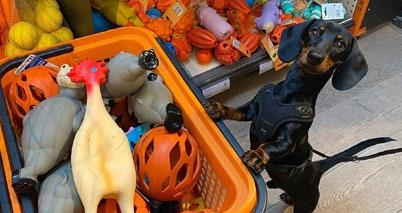
STRATEGY OF RISK MITIGATION
Given its potential impact, the product lifecycle management risk identified merit particular attention. For each identified risk, mitigation measures have been considered to limit exposure or reduce consequences.
ESG Topic Risk description
Product lifecycle management If legislation mandates a certain percentage of recycled materials in raw materials, purchasing costs will increase and margins will decrease for Tom&Co. Similarly, if legislation requires the recovery of packaging or products, additional costs will have to be absorbed.
Mitigation strategy
Packaging of Tom&Co’s own brands product being reviewed ahead of regulation changes, namely on the newly launched “GOOD” range with 100% recyclable packaging
POLICIES
The company is committed to managing the entire life cycle of its products responsibly, from design and sourcing to production, distribution, and end-of-life. Many pet products, from food packaging to accessories and care items, have a direct impact on resource consumption and waste generation. Managing their life cycle responsibly helps reduce landfill waste, lower carbon emissions, and promote a circular economy.
To achieve this, Tom&Co aims to minimize environmental impact by prioritizing sustainable materials, reducing waste, and encouraging recycling or reuse wherever possible.
ACTIONS AND TARGETS
This year, the company launched three new references of wild bird products made from recycled plastic.
Bulk sales have also increased, 100% of stores now offer
them. Most of the time, these bulk foods are wild bird food, rodent food or dog treats (100% of stores sell them). In total, the number of bulk references offered by Tom&Co per type of animal is: 12 birds, 6 rodents, 46 dog snacks. Currently, a store with a surface area of 400m² dedicates between 4 and 5m² to bulk products.
To better understand the environmental impact of its food products, Tom&Co has conducted a Life Cycle Analysis (LCA) study on 70 items via the «Dayrize» project. The results of this study will help guide future decisions on product sustainability as the tool calculates the CO2 tons, litres of water consumed and hectares of land used for each product.
For non-food products, Tom&Co has identified that the main raw materials used are metal, fabric/textile, cardboard, wood and plastic, often combined in different ways. However, no data is currently available on the percentage of certified raw materials. While it is not always possible to use 100% recycled raw materials in its products, the company wants to set future targets for responsible sourcing.

IN THE FUTURE
For each of its own-brand food products, Tom&Co aims to establish a sourcing specification document by 2026. This will define the criteria for raw material certification, focusing mainly on proteins and oils, and possibly extending to fish and meat sourcing. In the medium term, Tom&Co also aims to continue to increase its bulk product offering and the space in store dedicated to it. The number of bulk references in 2025 will remain the same for rodents and birds but will increase to 60 for dogs.
For its own-brand non-food products, Tom&Co will request technical data sheets from suppliers to determine the percentage of recycled content in materials such as cotton and plastic. Based on this information, the company will set specific targets by 2026 to increase the recycled content of its products and will introduce a performance indicator that measures the percentage of certified raw materials in its own-brand products. However, the company acknowledges that achieving 100% certification is not realistic, as some non-recyclable raw materials are used in very small quantities.
METRICS
The table below outlines the metrics that Tom&Co aims to track in the future regarding impacts on product lifecycle management issue. All KPIs are unavailable this year.
of fish and meat certified by type of food product in own brands
Percentage of raw materials certified AND recycled in total in all non-food own brand products. This KPI will be given by type of raw material (textile, metal, plastic, cardboard/ paper, wood, rubber etc.)
Percentage of stores (franchises included) which collect old/used articles
ESRS E5 WASTE MANAGEMENT
Tom&Co’s operations result in waste, primarily associated with logistics and in-store sales. It is essential that the company takes action to reduce waste at the source, as well as to sort it as selectively as possible. The reduction of waste, particularly residual waste, will also result in a reduction of associated costs.
WASTE MANAGEMENT IROS
KEY FIGURES AND ENGAGEMENT
99% of expired products are reused
100% of Belgian logistics waste retrieved by the logistics service provider
ESRS Sub- topic Location Impact, Risk or Opportunity Description
ESRS E5 – Resource use and circular economy
management
operations Real negative impact Waste generation linked to the logistics and distribution of products sold, and generation of in-store waste (litter).
Value chain Real negative impact Waste generation linked to the end-of-life of products sold (toys, accessories, bedding, etc.), particularly plastic waste, which is difficult to recycle and generally ends up in residual waste without being sorted.
Value chain Potential positive impact Cost reduction linked to waste tonnage if the volume of waste is reduced either by simple reduction or by sorting. Opportunity
Relocating production to European countries enables us to control production and the associated waste. Waste can then be processed by a more developed sorting and recycling system.
POLICIES
Tom&Co is committed to minimizing waste generation and promoting responsible waste management practices across all operations. The company prioritizes waste reduction, reuse, and recycling to divert materials from landfills and reduce environmental impact.
ACTIONS AND TARGETS
Tom&Co is committed to reducing waste and reusing expired products across its operations. In warehouses, 99% of expired products are reused or repurposed.
To avoid waste, Tom&Co first offers discounts on almost expired products to stores. If the stores no longer want these items, they are donated to shelters, ensuring that food and animal supplies are not wasted but used where they are needed.
In addition, logistics waste collection and treatment is managed by Distrilog and Vandepoel. These partners collect cardboard and plastic waste from stores and warehouses, process it and reuse it. This operation is only valid if the entire truck load is dedicated to Tom&Co, which is the case for 100% of the Distrilog (Belgium) trips.
IN THE FUTURE
In the medium term, a monthly procedure will be put in place to monitor expired products, ensuring that they are identified and managed efficiently before they expire.
In addition, the company is increasing the share of dedicated trips in France, therefore aiming for higher share of logistics waste retrieval and treatment in that country.
METRICS
The table below outlines the metrics that Tom&Co aims to track in the future regarding waste management issue. Two KPIs are unavailable this year.
Total weight of non-hazardous waste intended for disposal
Total non-hazardous waste diverted from disposal in stores, including:
- Reuse preparation;
- Recycling;
- Other recovery methods.
Total tons of product saved from destruction in warehouses (donation to shelters)
ESRS E5 SUSTAINABLE PACKAGING
The retail sector is a significant consumer of materials, particularly plastics, for packaging purposes. Tom&Co can contribute to decreasing this impact by identifying and eliminating any overpackaging practices that may contribute to environmental impact, as well as developing packaging solutions with a reduced environmental footprint.
KEY FIGURES AND ENGAGEMENT
ŀ 62% of Tom&Co’s own brand food packaging is recyclable
ŀ In 2024, 24% of product references have been converted to recyclable packaging
ŀ By 2029, 100% of its own-brand packaging (food and non-food) will be recyclable and all cardboard used will be FSC certified.
THE SUSTAINABLE PACKAGING IROS
ESRS Sub- topic Location Impact, Risk or Opportunity Description
ESRS E5 – Resource use and circular economy Sustainable packaging Value Chain Potential positive impact The manufacture and purchase of recycled packaging reduces the use of raw materials. The process of recycling materials reduces the intensity of resource extraction. Risk High prices for recycled packaging due to supply outstripping demand.
STRATEGY OF RISK MITIGATION
Given its potential impact, the sustainable packaging risk identified merit particular attention. For each identified risk, mitigation measures have been considered to limit exposure or reduce consequences.
ESG Topic Risk description
Mitigation strategy
Sustainable packaging High prices for recycled packaging due to supply outstripping demand. Tom&Co is actively managing its cost base beyond raw materials (eg optimizing logistics) to facilitate absorption of such events.

POLICIES
Tom&Co is committed to reducing the environmental impact of its own-brand packaging by prioritizing sustainable materials and designs. To address this, Tom&Co aims to minimize waste, use recycled and recyclable materials whenever possible, and reduce overall packaging volume. The company is also committed to influencing the broader industry, encouraging national brands to follow the same sustainability guidelines.
ACTIONS AND TARGETS
Tom&Co has made significant progress in analyzing and improving its own brand packaging. A detailed internal study was conducted to assess the recyclability of food packaging, which represents 80% of all Tom&Co packaging. The study examined product data sheets to determine the percentage of recyclable materials used.
Currently, 58% of Tom&Co’s own brand food packaging is recyclable. Materials such as 100% virgin cardboard, plastic (PE/PP), metal, aluminum and tetra packs are used. In metal-based packaging (e.g. cat and dog food cans & aluminium), 27% of own brand products are made from recycled metal. However, own brand aluminum trays (for cat or dog pâtés) are made exclusively from virgin aluminum.
Over the whole of 2024, 24% of product references have been converted to recyclable packaging. No survey has yet been conducted on the recyclability of national brand packaging.
IN THE FUTURE
Tom&Co has set clear sustainability targets for the coming years. By 2029, 100% of its own-brand packaging (food and non-food) will be recyclable and all cardboard used will be FSC certified.
A significant step in that direction will be achieved in 2025, with the transition from the “Tom&Co” brand for cat & dog kibbles to “GOOD”, which is offered in a new, recyclable packaging and will be available in store by mid-2025.
By 2025, the company will identify the percentage of recyclable and recycled packaging in its non-food categories. Tom&Co will aslo assess the percentage of FSC certified paper & cardboard in all its own brand products. By 2026, it will conduct a similar assessment for national brands to better understand their impact.
METRICS
The table below outlines the metrics that Tom&Co aims to track in the future regarding sustainable packaging issue.
SOCIAL
ESRS S1 SAFETY, HEALTH AND WELL-BEING
Staff are exposed to health risks (ergonomics, handling of heavy loads, etc.). Working conditions can be difficult due to staff shortages, customer attitudes and the challenge of balancing work and personal life in the retail sector. Tom&Co is committed to ensuring the safety and well-being of all its employees. A happy and healthy workforce is also a competitive advantage for the company. Integrated stores must also apply high working conditions standards and ensure legal compliance. In fact, as they represent the brand, any scandal or legal action in this area would have a negative impact on the brand’s image.
SAFETY, HEALTH AND WELL-BEING IROS
KEY FIGURES AND ENGAGEMENT
ŀ Tom&Co promotes the Dog Policy @Work, within the company and more broadly
ŀ In 2025, the company will launch an employee satisfaction survey to understand critical issues and how to tackle them
ESRS Sub- topic Location Impact, Risk or Opportunity Description
ESRS S1 – Own workforce Safety, health and well-being
Value Chain Potential negative impact Risk of attempts at collusion between suppliers and Tom&Co employees. Conflict of interest self-declaration under preparation.
Own operations Real positive impact The company guarantees a work-life balance for its head office employees.
Own operations Real positive impact The company encourages its employees to organize their private lives in such a way as to optimize their time and divide it efficiently between work and personal life.
Own operations Real negative impact Store working hours interfere with family life (e.g. evenings and weekends)
Own operations Real positive impact The company is committed to the personal fulfillment of its employees, and offers career development opportunities.
Own operations Real negative impact The intensity of work (logistics, transport, warehousing) can lead to physical exhaustion. The company ensures ergonomic practices at work (bending knees when carrying heavy objects, adapting office chairs, etc.).
Own operations Potential negative impact Physical damage was caused by accidents mainly related to logistics (pallet trucks, heavy loads, etc.).
Own operations Real negative impact Commercial activity and the lack of store staff lead to stressful situations and a feeling of loneliness on the part of employees.
Own operations Potential negative impact Contact with customers, and the aggressive behavior of some of them, creates stress for employees.
Own operations Potential negative impact
A robbery incident in one of the chain's stores can lead to trauma and PTSD (Post-Traumatic Stress Disorder) among the employees concerned.
Risk In the event of a scandal within a store or franchise, the company's image can be affected, with a direct impact on its results.
Risk Managerial responsibility for burn-out
Risk Absenteeism
Risk Recruitment difficulties
Risk Complaints, fines and legal proceedings
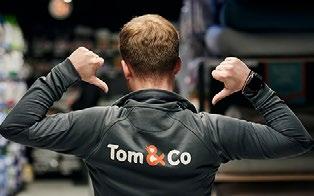
POLICIES
Tom&Co is committed to providing a safe, healthy and supportive work environment for all its employees. As a trusted leader in the pet care industry, Tom&Co recognizes that its success is built on the well-being of its people, store associates and logistics teams. Ensuring a positive and safe workplace is not only essential to employee satisfaction, but also to maintaining high service quality.
ACTIONS AND TARGETS
One of the main initiatives implemented is the Dog Policy @Work, which aligns with Tom&Co’s values by allowing employees to bring their dogs at work. The presence of dogs in the workplace indeed helps to reduce stress, improves morale and creates a more engaging work atmosphere.
In addition, Tom&Co promotes flexibility in working arrangements, including a remote working policy and flexible hours, ensuring that employees can better manage their professional and personal responsibilities.
IN THE FUTURE
Tom&Co will launch an employee satisfaction survey in 2025 to assess overall well-being and identify areas for improvement. Based on employee feedback, the company will adjust and refine its wellness programs to ensure they continue to meet the needs of its workforce.
To strengthen its safety culture, the company aims to launch a training and awareness program in the medium term to
STRATEGY OF RISK MITIGATION
Given their potential impact, four safety, health and well-being risks identified merit particular attention. For each identified risk, mitigation measures have been considered to limit exposure or reduce consequences.
ESG Topic Risk description Mitigation strategy
Safety, health, and well-being
Managerial responsibility for burnout
Absenteeism
Tom&Co will send a survey (2025) to its employees to understand the level of risk and possible actions
Tom&Co will send a survey (2025) to its employees to understand the level of risk and possible actions
Recruitment difficulties The company is working on employer branding, namely through the development of an L&D platform, the rebranding of the chain, its expansion plans etc.
Complaints, fines, and legal proceedings The company has relevant insurance for employee health & safety issues
help employees identify and mitigate occupational risks, particularly in stores and logistics operations, where proper product handling and compliance with safety protocols are essential.
Recognizing the growing importance of mental health, Tom&Co also aims to implement stress and burnout prevention programs over the next 5 years, providing employees with tools and support to manage psychosocial risks.
METRICS
The table below outlines the metrics that Tom&Co aims to track in the future regarding safety, health and well-being issue. One KPI is unavailable this year but will be available next year.
KPI
For all employees: The number of recordable work-related health topics & the main types of work-related health problems.
Number of accidents related to work
Workload measured thanks to survey (available next year 2025)
Percentage of employees having followed a training on safety, health & wellbeing
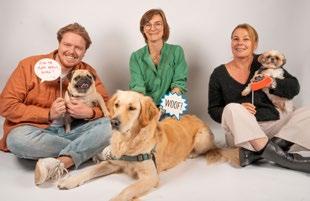
Unit 2024
Number Physical health issues at work: 7
Physical health issues due to traffic: 3
Mental health issues due to workload: ND
Number 9
Score ND
% 0%
ESRS S4 ACCESSIBILITY OF PRODUCTS AND SERVICES
Tom&Co wants to guarantee geographical accessibility, which means having outlets that are well located and, where possible, accessible by low-carbon transport. The shops and website should also be accessible to people with handicap. Finally, improving the affordability of products and services will enable more vulnerable pet owners to benefit from quality products and provide adequate care for their pets.
KEY FIGURES AND ENGAGEMENT
ŀ In 2024, ~4 500 products were available online
ŀ 2 new stores were opened in 2024 in France
ŀ Tom&Co has always welcomed pets into its stores
ACCESSIBILITY OF PRODUCTS AND SERVICES IROS
ESRS Sub- topic Location Impact, Risk or Opportunity Description
ESRS S4 – Consumers and end-users Accessibility of products and services

Own operations Real positive impact In the event of a lawsuit relating to damages caused to the consumer and/or user, the company will cover the costs of damages and interest.
Opportunity
Retention of customers, stability of the average basket and sustainability of sales thanks to affordable prices.
Risk In the event of legal action related to harm caused to consumers and/or users, the company will have to cover damages and compensation costs.
STRATEGY OF RISK MITIGATION
Given its potential impact, the accessibility of products and services risk identified merit particular attention. For each identified risk, mitigation measures have been considered to limit exposure or reduce consequences.
ESG Topic Risk description Mitigation strategy
Accessibility of products and services In the event of legal action related to harm caused to consumers and/ or users, the company will have to cover damages and compensation costs.
Tom&Co tracks closely events of quality issues and has an emergency procedure in place to limit the impact of such events
POLICIES
As a trusted pet care provider, Tom&Co recognizes the importance of making high-quality pet products available to every pet owner, ensuring that all animals receive the care they need. Accessibility is particularly crucial in rural areas andfor customers with mobility challenges.
To uphold this commitment, Tom&Co strives to design and distribute products that are inclusive, affordable, and easy to use.
ACTIONS AND TARGETS
In 2024, Tom&Co continues to develop and improve its services to improve accessibility for pet owners. While no new stores were opened in Belgium, two new sites were opened in France. In Belgium, one in three stores now offers a Dog Wash, a service that has grown in popularity and will continue to grow in the years to come.
Tom&Co has always welcomed all animals into its stores, reinforcing its commitment to creating a pet-friendly environment.
In addition, the company offers home deliveries to improve product accessibility, particularly for elderly customers or those with reduced mobility. While this initiative is not exclusively aimed at seniors, it offers a practical solution for those who may have difficulty getting to the store. Some franchisees have also set up direct home deliveries, and Tom&Co continues to assess the viability of expanding this service.
IN THE FUTURE
Over the next four years, Tom&Co aims to have every store offer a Dog Wash, ensuring customers have convenient and affordable grooming options for their pets.
The company is developing its e-Commerce presence across its geographies namely through: Pharmapets in Belgium and the Netherlands, Vetostore in France and the Tomandco.com website in both countries. The aim is to double the size of the e-Commerce by 2025.
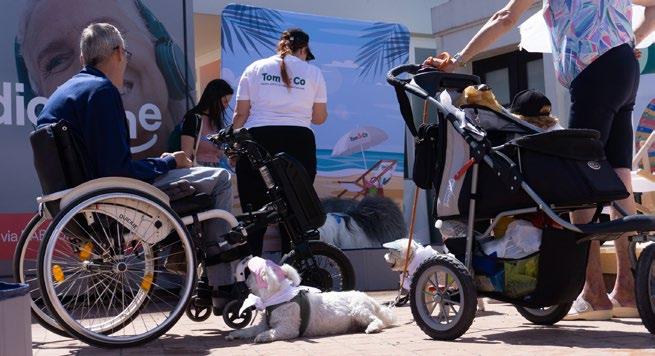
METRICS
The table below outlines the metrics that Tom&Co aims to track in the future regarding accessibility of products and services issue.
KPI
Number of products available online
Number of stores per ‘000 km2 per country
Unit 2024
Number 4 423 - 4 547 (depending on site language)
Number FR: 0,1 / BE: 4,3 / LUX: 0,8
GOVERNANCE
ESRS G1 - ANIMAL WELFARE
As a pet specialty retailer, Tom&Co has a duty to promote and improve practices relating to the welfare and respect of animals, both in its own activities and upstream, in its supply chain, and downstream, among pet parents. The benefits of companion animals for mental, social and physical health, as well as emotional and psychological development, have been proven. In response, Tom&Co wants to contribute to a better understanding of animal welfare and to promote better practices in society. The fight against the abandonment of pets is also a key issue for a pet specially retailer. To this end, the company positions itself as a privileged partner of the authorities on issues of animal welfare and respect and works with associations.
ANIMAL WELFARE IROS
KEY FIGURES AND ENGAGEMENT
ŀ 100% of company-owned stores have participated in a donation drive for shelters
ŀ 44% of Belgian integrated stores has at least one person trained in the recognized Tom&Co pet certification
ŀ Tom&Co always applies the strictest regional regulations on animal welfare in-store when there are regional discrepancies
ŀ Since 2021, a transfer certificate has been introduced to ensure that customers who purchase an animal have the necessary equipment to care for it. In 2024, 100% of animals sold (except fish) leave the store with this certificate.
ŀ Tom&Co is determined that 99% of their products are respectful of animal welfare in the medium term.
ESRS Sub- topic Location Impact, Risk or Opportunity Description
ESRS G1 - Business Conduct Animal Welfare
Own operations Potential negative impact While many initiatives are put in place to ensure flawless treatment of live animals in store, the company cannot guarantee 0 incidents.
Value Chain Potential negative impact While the Tom&Co regularly audits its largest live animals suppliers, it cannot guarantee flawless treatment throughout the value chain.
Value Chain Real negative impact Intensive farming can include animal abuse.
Value Chain Real positive impact Compliance with welfare legislation in stores and for customers in Wallonia, an adoption certificate is needed. In France, a cooling-off period was introduced for rabbits (to combat animal abandonment).
Value Chain Potential positive impact The company is committed to training its staff and customers in animal welfare, both in the store and in the customer's home.
Value Chain Potential positive impact The company is committed to raising awareness and educating owners about pet adoption.
Own operations Real positive impact The company offers training in animal welfare, recognized in the 3 Belgian regions. 150 employees have graduated from this training and 30% of all staff (including HQ) have at least passed the first module.
Own operations Potential positive impact The company is committed to raising awareness and educating owners about pet adoption.
Opportunity
Opportunity
Opportunity
Opportunity
Risk
Risk
Improved animal health means longer life and greater customer satisfaction. All this can lead to increased sales.
Increased sales by attracting new customers
Increased sales due to higher customer retention rate
Increased sales due to higher shopping baskets
Risk of fines, lawsuits, scandals, animal turnover
Reduced sales: if customers don't have an adoption certificate, they can't adopt an animal.
STRATEGY OF RISK MITIGATION
Given their potential impact, the animal welfare risks identified merit particular attention. For each identified risk, mitigation measures have been considered to limit exposure or reduce consequences.
ESG Topic Risk description
Mitigation strategy
Animal Welfare Risks of fines, lawsuits, scandals, and animal turnover. Tom&Co holds the highest standard in terms of animal welfare in-store, ensuring all stores comply with the strictest regional or national regulations. Tom&Co offers advanced & officially recognized animal welfare training to limit this risk.
Reduced sales: if customers don't have an adoption certificate, they can't adopt an animal.
POLICIES
Since Tom&Co sells animals as well as food and non-food products for them, animal welfare is at the heart of its concerns. That is why Tom&Co supports pet parents with practical advice to ensure animal well-being at every stage of life. This commitment extends across the company’s value chain, promoting responsible and sustainable practices downstream and supporting animal shelters and pet wellbeing overall.
ACTION AND TARGETS
Since 2024, Tom&Co has implemented several actions in their stores, with its employees, suppliers and with shelters to act on animal welfare.
In stores
Aware of the differences in animal welfare legislation depending on the regions of Belgium, Tom&Co has chosen to apply the strictest standards in all its stores since 2023. For example, rabbits are now kept in closed adapted parks instead of cages and betta fish receive 10 L of water, even in regions where only 5 L is required. Additionally, as certain animals may or may not be sold depending on the region (e.g. certain type of turtles), Tom&Co has developed its own «Positive Animal List» (see annexes B), identifying species that they believe can live in captivity. The condition for an animal not on this list to be sold in a designated store is that a recognized expert on that animal is employed in the store. Tom&Co has also taken steps to improve the selection of animal welfare products. For example, they stopped selling cages deemed too small (based on scientific research) and removed electric anti-bark collars from their product line before legislation banned it.
Tom&Co has proactively set up separate requirements on animal adoption (e.g., need to fill in forms, right for store staff to refuse selling animals if they judge the living situation will not be appropriate), limiting the impact of additional regulations going in that direction
Tom&Co is committed to keeping animals in stores for as little time as possible, avoiding overcrowding and ensuring good living conditions.
From a legal point of view, all stores adhere to quarterly veterinary visits (except if the store has only fish, an annual check is then foreseen). When an animal is sick, a veterinarian is called immediately. In addition, 100% of the animals sold, with the exception of fish, come from BENELUX or neighboring countries.
Since 2021, a transfer certificate has been introduced to ensure that customers who purchase an animal have the necessary equipment to care for it. In 2024, 100% of animals sold (except fish) leave the store with this certificate. If a Tom&Co employee considers that the well-being of an animal is threatened, he has the right to refuse the sale. Concerning fish, the certificate is not systematic, but the seller can request it if he has doubts about the future conditions of keeping the fish.
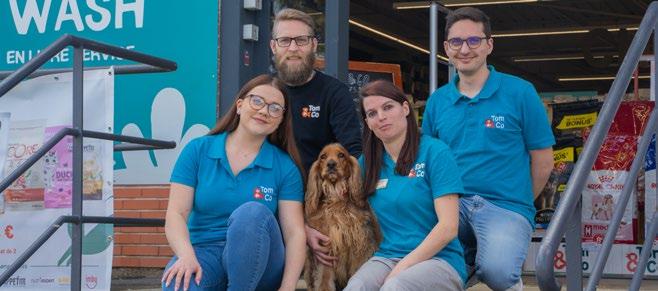
At suppliers
In order to maintain high standards, the largest suppliers are visited each year to verify compliance with specifications, particularly in terms of traceability and animal care conditions.
Certified training in animal welfare
To guarantee high standards of care, Tom&Co has developed certified training, recognized by Flanders, Brussels and Wallonia. In 2024, an important milestone was reached: the training was moved entirely online and is now divided into 11 e-learning modules with assessments after each. There are also two days of face-to-face training (after the 5th and 9th modules) and a final exam in an open course format. The complete training includes 50 hours of e-learning, and the diploma, once obtained, is valid for life. In 2024, 27 additional people obtained their certification, for a total of 150 certified employees. As a result, 44% of Belgian integrated stores have at least one person that has the certification.
Since 2024, Tom&Co has decided to make module 1 (“Ethics, responsibility and commitment of Tom&Co”) compulsory for all employees. The aim is for 100% of Tom&Co staff to be trained in this module by the end of 2025. This module covers key topics such as animal welfare principles, commitment to animals and responsible communication (e.g. no posting photos of animals in store on social media in order to avoid impulsive purchases and thus reduce abandonment; train them to educate clients with the «pet parent guide»).
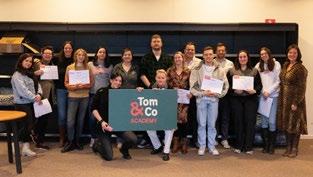


Supporting animal shelters
Tom&Co also contributes to animal welfare beyond its stores. Each year, the company hosts “Ecuelles du Cœur,” a nationwide fundraising campaign where customers can donate money or pet supplies. Shelters can then use these funds to purchase necessary materials from Tom&Co stores. 100% of Tom&Co stores, including franchises, actively participate in this initiative.
In addition to the national “Ecuelle du Coeur” initiative, all integrated stores (and the large majority of franchisees) have partnered with one or more shelters and proactively donates unsold items or supports them in another way (for example through in-store communication).
At the Tom&Co warehouses as well, unsold food articles are donated before they expire.
IN THE FUTURE
In the future, Tom&Co is committed to continuously push animal welfare as a key value among its employees, customers and broader society. To achieve this, several actions will be implemented.
Tom&Co is determined that 99% of their own brand products sold in stores will be respectful of animal welfare by the end of 2026. To do this, Tom&Co continues to work on the specifications of all its items so that they meet the highest standards of care and responsibility for the animals they cater to.
Tom&Co is working to enrich its own animal welfare training by adding a new module focused on providing nutritional advice and strengthening knowledge on animal welfare. This adaptation is planned in the short term. Tom&Co is working to ensure that its diploma training is recognized in France. However, each store has a «capacitaire», meaning a person certified by the French state to sell animals.
METRICS
The table below outlines the metrics that Tom&Co aims to track in the future regarding animal welfare issue.
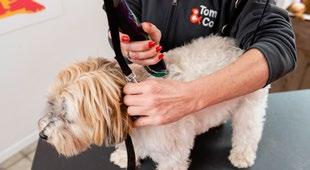
Percentage of Belgian integrated stores with at least one person trained in the Tom&Co pet certification (for stores that sell animals).
Percentage of company-owned stores that have participated in a donation drive for shelters at least once during the year.
Percentage of stores (company-owned and franchised / Belgium and France) that have been audited this year for animal welfare, ensuring compliance with Tom&Co standards
44%
ESRS G1 – ETHICS AND GOVERNANCE
Tom&Co wants to ensure transparent, fair and responsible governance. This means complying with the law, preventing and actively combating corruption and honouring commitments. Good governance also includes accountability, effective risk management and honest communication with employees, customers and partners. Tom&Co must also ensure that its suppliers and partners follow the same principles.
ETHICS AND GOVERNANCE IROS
KEY FIGURES AND ENGAGEMENT
ŀ 100% of Tom&Co employees working in the purchasing department will receive training on conflict of interest by 2026
ŀ NPS: 68 of customer satisfaction
ESRS Sub- topic Location Impact, Risk or Opportunity Description
ESRS G1 - Business Conduct Ethics and Governance
Chain
positive impact
company works closely with suppliers to ensure the respect of animal wellbeing practices
of hacking or cyber-attacks; it is essential to have a solid and audited financial plan, along with insurance protection.
STRATEGY OF RISK MITIGATION
Given its potential impact, the ethics and governance risk identified merit particular attention. For each identified risk, mitigation measures have been considered to limit exposure or reduce consequences.
ESG Topic Risk description Mitigation strategy
Ethics and Governance Risks of hacking or cyber-attacks; it is essential to have a solid and audited financial plan, along with insurance protection.
Tom&Co has implemented essential security measures such as anti-virus and anti-spam filtering, firewall protection, secure VPN connections, multi-factor authentication (MFA) and regular server updates. Consumer data in the brand new checkout system is hosted in a private SaaS environment, ensuring full GDPR compliance. To further strengthen cybersecurity, Tom&Co plans to implement a SIEM/SOC environment in 2025, enabling 24/7 proactive monitoring of suspicious activity, with automated alerts and response actions to protect sensitive information.
POLICIES
Tom&Co operates in a sector that requires high ethical standards, particularly in areas such as animal welfare, consumer protection, and franchise management. By reinforcing governance practices, the company ensures consistency across all stores, both company-owned and franchised, while also meeting regulatory requirements and reinforcing customer confidence. This approach not only safeguards the company’s reputation but also strengthens its relationships with partners, suppliers, and consumers.
ACTION AND TARGETS
In 2023 & 2024, Tom&Co has started its path towards a more transparent and safe governance. A specific hacking / cyberattack insurance was namely contracted in 2023. In addition, Tom&Co has started formalizing its internal governance, defining clearly the rights and responsibilities of its Exco members and employees.
IN THE FUTURE
In 2025, a company-wide employee survey will be conducted to assess engagement and gather insights.
By 2026, 100% of Tom&Co employees in the purchasing department will receive training on conflict of interest prevention and compliance, ensuring ethical decisionmaking throughout the organization.
To strengthen sustainability and responsible business practices, Tom&Co will set up an ESG working group in 2025.
In the short term, senior management will be required to:
ŀ Sign a declaration on conflict of interest prevention, highlighting the company’s commitment to transparency and integrity.
ŀ Take a training on hacking and cyber-attack, including a mock attack.
In addition, Tom&Co is also working on embedding the newly formalized governance in its processes, therefore ensuring the new principles are respected.

METRICS
The table below outlines the metrics that Tom&Co aims to track in the future regarding ethics and governance issues. One KPI is unavailable this year.
ESRS G1 – PARTNERSHIPS
Tom&Co’s ecosystem is made up of many partnerships, whether in terms of supply, logistics, distribution of products and services or its role in promoting animal welfare. Maintaining its current partnerships through transparency and enhanced dialogue, and forging new ones, means improving the company’s resilience and ability to fully implement its strategy. These partnerships will facilitate industry-wide changes, driving the adoption of more sustainable practices.
PARTNERSHIPS IROS
KEY FIGURES AND ENGAGEMENT
ŀ 100% of integrated stores have a partnership in place with at least one shelter
ŀ Initiatives with Natogora, Natuurpunt and VogelWeekend have taken place in 2024
ESRS Sub- topic Location Impact, Risk or Opportunity Description
ESRS G1 - Business Conduct Partnership Own operations Real positive impact Support for animal protection and welfare initiatives thanks to a whistle-blowing system.
Own operations Real positive impact The company supports animal shelters and NGO’s focusing on the link between animals and humans
POLICIES
As a market leader, Tom&Co recognizes its responsibility to society and the unique bond between humans and animals. It is well established that animals provide valuable support to humans, just as humans have a duty to care for and protect them. With this in mind, Tom&Co is committed to promoting this relationship, raising awareness, and ensuring that its partnerships reflect these values.
Tom&Co collaborates only with organizations that share its commitment to animal welfare, ethical business practices, and social responsibility. Every strategic partnership must deliver real value, support long-term goals, and adhere to the highest ethical, environmental, and social standards.
ACTION AND TARGETS
In 2024, Tom&Co strengthened its commitment to animal welfare and community support by expanding its partnerships with shelters and organizations. Currently, 100% of integrated stores have a partnership in place, while the majority of franchise stores also contribute, although Tom&Co does not have the exact percentage.
A set of concrete initiatives are set up with these shelters:
ŀ Donation bins in which customers can leave used pet items for shelters, providing direct support to animals in need.
ŀ Écuelles du Cœur is a program allowing customers to purchase a voucher (2,53 / 53 or 103), which shelters can then exchange for essential pet supplies. This system ensures that donations are tailored to the specific needs of each shelter, maximizing their impact.
ŀ Donations directly from the warehouse (see section on Waste Management)
In addition, Tom&Co collaborated in 2024 with NatuurPunt, Natagora and VogelWeekend, actively communicating about their operations and supporting their environmental and wildlife conservation efforts.
Training sessions were also held in-store on animal-based exercise and its health benefits. These sessions were led by Anthony Lemoine.
IN THE FUTURE
As of 2025, Tom&Co wants to improve the quality of its partnerships by taking stock of existing collaborations and selecting those that have the most impact. This evolution will allow the company to focus its resources on quality partnerships, in line with its values. In parallel, efforts will be made to structure and standardize agreements with partner shelters of all franchises by end of 2026, ensuring better organization and monitoring of these collaborations. Beyond its support for animal welfare, Tom&Co recognizes the essential role that animals play in human well-being and

is committed to highlighting this connection. The company plans to partner with the Belgian assistant dog federation. This association is focused on finding host families to train assistance dogs for people in need, providing these trained dogs for free. The Belgian Assistance Dogs Federation supports all sorts of assistance dogs, for a broad range of conditions such as blindness, motor handicaps, autism, epilepsia (alert dogs) or even simply social support for the elderly. Through this collaboration, Tom&Co hopes to highlight the positive impact animals have on human life.
METRICS
The table below outlines the metrics that Tom&Co aims to track in the future regarding partnerships issue.
Number of joint projects completed by each partner
Number NatuurPunt : 1
Ecuelle du cœur : 1
Refuges intégrés : N/A (available next year 2025)
ESRS G1 – RESPONSIBLE MARKETING
The regulatory context is tending to demand ever higher levels of consumer information and respect for privacy. Tom&Co is part of this trend, whether in terms of data protection or avoiding greenwashing practices. Responsible marketing must also enable customers to choose the most sustainable products that are best suited to the well-being and health of their animals.
RESPONSIBLE MARKETING IROS
KEY FIGURES AND ENGAGEMENT
ŀ To curb impulse purchases and reduce pet abandonment, the company has implemented a strict policy prohibiting the publication of photos of animals for sale in store on social media, excluding all live animals promotion and actively promoting adoption
ŀ 0 substantiated complaints about customer privacy
ESRS Sub- topic Location Impact, Risk or Opportunity Description
ESRS G1 - Business Conduct Responsible marketing Value Chain Real positive impact
Opportunity
POLICIES
As a market leader in pet care, Tom&Co is committed to delivering truthful, transparent, and responsible marketing of its products and services while prioritizing animal welfare, consumer education, environmental sustainability, and data protection. Given its commitment to animal well-being and ethical business practices, all promotional materials will reflect the company’s values of care, accuracy, and social responsibility, avoiding any messaging that could encourage impulse purchases or misinformation about pet care. Additionally, as digital interactions increase, protecting customer data is essential to maintaining security and upholding privacy standards.
ACTIONS AND TARGETS
In terms of traceability, the company ensures that all its branded products meet minimum legal requirements, including detailed ingredient lists and nutritional values.
To curb impulse purchases and reduce pet abandonment, the company has implemented a strict policy prohibiting the publication of photos of animals for sale in store on social media, excluding all live animals promotion and actively promoting adoption. Data protection remains a priority for
The company is committed to raising awareness and educating owners about pet adoption.
An increase in sales thanks to the company's commitment as a positive player in the field of animal welfare, in particular by raising owners' awareness of the benefits of adopting a pet.
Tom&Co. The company has implemented essential security measures such as anti-virus and anti-spam filtering, firewall protection, secure VPN connections, multi-factor authentication (MFA) and regular server updates. Consumer data in the brand new checkout system is hosted in a private SaaS environment, ensuring full GDPR compliance.
IN THE FUTURE
Moving forward, Tom&Co is exploring ways to improve consumer information about its own brand products. The company will explore how to provide clearer information on ingredient sourcing, such as the origin of ingredients, and the best choices for specific animal breeds. This information will be integrated by product family, so pet owners can make informed purchasing decisions.
Additionally, Tom&Co is committed to strengthening its support for shelter partners by improving their in-store visibility. The aim is to display in-store signage promoting shelters (shorter term), as well as provide a dedicated communication platform (longer term) where customers can learn more about the animals available for adoption. This initiative is part of the company’s broader mission of responsible pet ownership and animal welfare advocacy.

To further strengthen cybersecurity, Tom&Co plans to implement a SIEM/SOC environment in 2025, enabling 24/7 proactive monitoring of suspicious activity, with automated alerts and response actions to protect sensitive information.
METRICS
The table below outlines the metrics that Tom&Co aims to track in the future regarding responsible marketing issue. One KPI is unavailable this year but will be available next year.
Total substantiated complaints about customer privacy
Number of incidents that potentially compromised employee or customer personal data
Time between the detection of an incident involving customer data and the notification of the incident (not yet available but will be for 2025)
1 (breach in September - after tests, it was confrimed it did not compromise any data)
APPENDIX
APPENDIX A : COMPOSITION AND PRESENCE OF THE WORKING GROUP
Name Title
Jean Richard de Latour Chief executive officer (CEO)
Juliette Hamer Chief of Staff
Thierry le Grelle Board member – Ex CEO
Jonathan Beckers-Vieujant Ex-Tom&Co membre
Hilde Decadt Chief Operating Officer (COO) – Belgium
Wouter Lefevere Chief Commercial Officer
Herbert Delahaije Group Legal Counsel
Charlotte Binst Ex-Tom&Co membre
Vanessa Nicolai Ex-Tom&Co membre
Sven De Waele Chief E-Commerce & Digital Officer
Philippe De Moor Ex-Tom&Co membre
Samuel Jodeau Chief Operating Officer (COO) – France
Elodie Bodin Packaging manager
Luc De Praet Market Expert Petfood
Alexandra Van Eecke Ex-Tom&Co membre
Emilie Willemarck Animal Well-being expert
Michael Verstappen Director Store Format – Technical Support & B2B Customer Service
Marvin Vanparys Supply Chain Coordinator
Peter Coppens IT Director
Cleo De Vits Quality Manager
Workshop Impact, Risks, Opportunities (Environment & Governance)
Workshop Impact, Risks & Opportunities (Social) Workshop Listing Stakeholder Workshop Risks and Opportunites Scoring Workshop KPI Workshop Actions Interviews about current politics, actions and targets for each material topic
APPENDIX B : STAKEHOLDER CONSULTATION
Here are the more detailed results of the stakeholder consultation. Of the 180 comments, 105 concerns internal stakeholders and 75 concerns external stakeholders. More details on the completion rate are provided in the following table.
APPENDIX C : SUMMARY OF ALL METRICS
Percentage of certified raw materials used to manufacture the organization's main products and services (available next year 2025)
of fish and meat certified by type of food product in own brands
Percentage of raw materials certified AND recycled in total in all non-food own brand products. This KPI will be given by type of raw material (textile, metal, plastic, cardboard/paper, wood, rubber etc.) (available next year 2025)
(franchises included) which collect old/used articles
Total non-hazardous waste diverted from disposal in stores, including:
-Reuse preparation; -Recycling; -Other recovery methods.
Total tons of product saved from destruction in warehouses (donation or to refugee centers)
SOCIAL
For all employees: The number of recordable work-related health topics & the main types of work-related health problems.
Phyiscal health issues at work: 7
Physical health issues due to traffic: 3
Mental health issues due to workload: 18
Number of accidents related to work
Workload mesured thanks to survey (available next year 2025)
Percentage of employees having followed a training on safety, health & wellbeing
Number of products available online
(depending on site language) Number of stores per ‘000 km2 per country
GOVERNANCE
Percentage of Belgian integrated stores with at least one person trained in the Tom&Co pet certification (for stores that sell animals).
Percentage of company-owned stores that have participated in a donation drive for shelters at least once during the year.
Percentage of stores (company-owned and franchised / Belgium and France) that have been audited this year for animal welfare, ensuring compliance with Tom&Co standards
Promoter
(NPS) – Customer Satisfaction
Net Promoter Score (NPS) – Employee Satisfaction (available next year 2025)
Number of formal complaints linked to behavior within the company
Number of joint projects completed by each partner
NaturePunt : 1
Ecuelle du cœur : 1
Refuges intégrés : N/A (available next year 2025)
Total substantiated complaints about customer privacy
Number of incidents that potentially compromised employee or customer personal data Number 1 (breach in September - after tests, it did not compromise any data)
Time between the detection of an incident involving customer data and the notification of the incident (not yet available but will be for 2025)
Percentage of products for which traceability information is available to customers
APPENDIX D : POSITIVE ANIMAL LIST
Fish
Small mammals Birds
List A: includes compatible fish for volumes from 20 l to 150L Domestic rabbit
Paracheirodon axelrodi Guinea pig Cockatiel
Paracheirodon innesi Chinese dwarf hamster Diamond dove
Paracheirodon simulans Campbell's dwarf hamster Red-collared lorikeet
Hyphessobrycon Herbertaxelrodi Roborovski dwarf hamster Gouldian finch
Hyphessobrycon Megalopterus Russian dwarf hamster (Djungarian hamster) Silver-beaked mannikin
Hyphessobrycon Rosaceus ( Whitefin ) Mongolian gerbil Bronze mannikin
Hyphessobrycon Flammeus Golden hamster
Java sparrow (Java finch)
Hyphessobrycon Bentosi Domestic mouse Society finch (Bengalese finch, Japanese sparrow)
Hyphessobrycon Roseus Domestic rat Long-tailed finch
Hyphessobrycon Pulchripinnis Degus (Chilean degu)
Hyphessobrycon Sweglesi Domestic chinchilla
Hyphessobrycon Columbianus
Hyphessobrycon Melanostichos
Hyphessobrycon Eques
Prionobrama Filigera
Aphyocharax Rathbuni
Prionobrama Filigera
Nannostomus beckfordi
Nannostomus marginatus
Nannostomus unifasciatus
Nannostomus rubrocaudatus
Nannostomus eques
Hemigrammus Erythrozonus
Hemigrammus Ocellifer
Hemigrammus Pulcher
Hemigrammus Bleheri
Reptiles and amphibians
Chéloniens (turtles)
Sternotherus minor
Sternotherus odoratus
Pelomedusa subrufa s.l.
Graptemys pseudogeographica
Mauremys reevesii
Mauremys sinensis
Testudo graeca ssp. Ibera s.l.
Testudo hermanni ssp.
Bicheno finch (Double-barred finch)
Star finch
Zebra finch
Canary
Chinese painted quail
Ophidiens (snakes)
Corallus hortulanus
Morelia spilota
Morelia viridis
Python anchietae
Ornamental domestic chicken (rooster) Python regius
Peach-faced lovebird
Thamnophis eques
Fischer’s lovebird Thamnophis proximus
Masked lovebird (Black-masked lovebird) Thamnophis sirtalis
Liliane’s lovebird (Nyasa lovebird) Elaphe bimaculata
Black-cheeked lovebird Lampropeltis triangulum
Barred parakeet (Lineolated parakeet) Pantherophis guttatus
Red-fronted kakariki
Pacific parrotlet (Pocket parrot, Celestial parrotlet) Sauriens (lizards)
Budgerigar (Common parakeet) Pogona henrylawsoni
Bourke’s parakeet
Eastern rosella
Pogona vitticeps
Chameleo calyptratus
Fish
Small mammals Birds Reptiles and amphibians
Hemigrammus Rodwayi Crimson rosella (Pennant’s parakeet) Furcifer pardalis
Aphyocharax Rathbuni
Gasteropelecus Sternicla
Carnegiella Marthae
Hasemania Nana
Gymnocorymbus Ternetzi
Moenkhausia Pittieri
Nematobrycon Palmeri
Nematobrycon Lacortei
Moenkhausia Costae
Pristella Maxilaris
Boehlkea Fredcochui
Axelrodia Riesei
Inpaichthys Kerri
Carnegiella Strigata Strigata
Gasteropelecus Maculatus
Thoracocharax Stellatus
Phenacogrammus interruptus
Astyanax Mexicanus
Rasbora Borapetensis
Trigonostigma Heteromorpha
Tous le genre danio.
Tanichthys Albonubes
Pethia Gelius
Puntius Titteya
Desmopuntius Pentazona
Barbodes Schuberti (Barbodes semifasciolatus)
Pethia Nigrofasciata
Pethia Conchonius
Desmopuntius Rhomboocellatus
Haludaria Fasciata
Pale-headed rosella
Timon pater
Correlophus ciliatus
Rhacodactylus auriculatus
Coleonyx elegans
Coleonyx mitratus
Coleonyx variegatus
Eublepharis macularius
Hemitheconyx caudicinctus
Gekko auratus
Gekko gekko
Gekko vittatus
lepidodactylus lugubris
Lygodactylus picturatus
Pareodura picta
Phelsuma grandis
Phelsuma klemmeri
Phelsuma kochi
Phelsuma laticauda
Phelsuma lineata
Phelsuma madagascariensis
Phelsuma ornata
Phelsuma quadriocellata
Uroplatus fimbriatus
Uroplatus sikorae
Tiliqua scincoides
Tribolonotus gracilis
Lepidothryris fernandi
Eutropis multifasciata
Crotaphytus collaris
Crotaphytus bicinctores
Fish
Desmopuntius Hexazona
Oliotius Oligolepis
Notropis Chrosomus
Tous les rasboras & barbus nains comme :
Boraras Brigittae
Boraras maculatus ( Merah)
Boraras urophthalmoides
Trigonostigma Hengeli
Toutes les espèces de Garra
Puntigrus Tetrazona
Carassius auratus "Fantail"* voir blacklist de certaines variétés
Carassius auratus (classic, comet, shubunkin, wakin, jinkin
Poecilia reticulata
Poecilia Wingei
Poecilia Sphenops
Poecilia Velifera
Micropoecilia sp.
Xiphophorus helleri
Heterandria Formosa
Genre Limia comme :
Limia Tridens
Limia Islai
Limia melanogaster
Jordanella Floridae
Aplocheilus Lineatus
Nothobranchius Guentheri
Betta splendens sp.
Macropodus opercularis
Trichogaster chuna
Trichogaster lalius
Trichopodus leerii
Trichopodus Trichopterus
Small mammals Birds Reptiles and amphibians
Anolis carolinensis
Anolis equestris
Anolis sagrei
Sceloporus malachitus
Amphibiens
Ceratophrys cranwelli
Ceratophrys cornuta
Dendrobates auratus
Dendrobates leucomelas
Dendrobates nubeculosus
Dendrobates tinctorius
Dendrobates truncatus
Agalychnis callidryas
Theloderma corticale
Dryophites cinereus
Bombina orientalis
Ambystoma mexicanum
Dryopsophus caeruleus
Fish
Parosphromenus deissneri
Parosphromenus anjunganensis
Trichopsis vittata
Tateurndina ocellicauda
Otocinclus vittatus
Otocinclus Affinis ( Macrotocinclus affinis)
Ancistrus Cf. Cirrhosus
Ancistrus dolichopterus
Ancistrus sp.
Pangio kuhlii
Pangio Oblonga
Mikrogeophagus ramirezi
Apistogramma Cacatuoides
Tous les apistogrammas non repris en A
Dicrossus filamentosus
Ptérophyllum scalare
Pelvicachromis taeniatus
Pelvicachromis pulcher
Caridina Multidentata
Atyopsis moluccensis
Neritina sp.
Scabies crispata
Beaufortia leveretti
Gastromyzontidae
Sewellia lineolata
Gyrinocheilidae
Gyrinocheilus aymonieri
Hemirhamphodon sp.
Redigobius Balteatus
Chlamydogobius Eremius
Small mammals Birds Reptiles and amphibians
Fish
Stigmatogobius Sadanundio
Brachygobius Doriae
All pseudomugil
Iriatherina werneri
Marosatherina ladigesi
Corydoras pygmeus
Corydoras habrosus
Botia striata
Kryptopterus minor ( bicirrhis )
Mochokidae
Synodontis nigriventris
Synodontis sp. polli white
Synodontis lucipinnis
Centromochlus perugiae
Hara jerdoni
Carinotetraodon travancoricus
Carinotetraodon imitator
Dichotomyctere ocellatus
Dario dario
Dario hysginon
Badis Badis
List B (Confirmed): includes compatible fish up to 600 L
Prionobrama Filigera
Metynnis Hypsauchen
Sahyadria Denisonii
Epalzeorhynchos Kalopterus
Epalzeorhynchos bicolor
Epalzeorhynchos Frenatus
All Crossocheilus
All Melanotenia
All Glossolepis
Small mammals Birds Reptiles and amphibians
Fish
All Chilatherina
Thorichthys Meeki
Astronotus Ocellatus
Symphysodon aequifasciatus
Julidochromis ornatus
Neolamprologus sp.
Neolamprologus brichardi
Neolamprologus Pulcher Daffodil
Aulonocara baenschi
Aulonocara baenschi
Labidochromis sp.
Chindongo saulosi Taiwanee Reef
Melanochromis auratus
Maylandia lombardoi
Labidochromis Chisumulae
Nimbochromis linni
Cherax peknyi
Cherax sp.
All Caridina et Neocaridina
Cambarellus patzcuarensis
All Pachychilidae
Anentome helena
Channa andrao
Channa aurantimaculata
Mastacembelus erythrotaenia
Mastacembelus frenatus
Macrognathus pancalus
All polypterus
